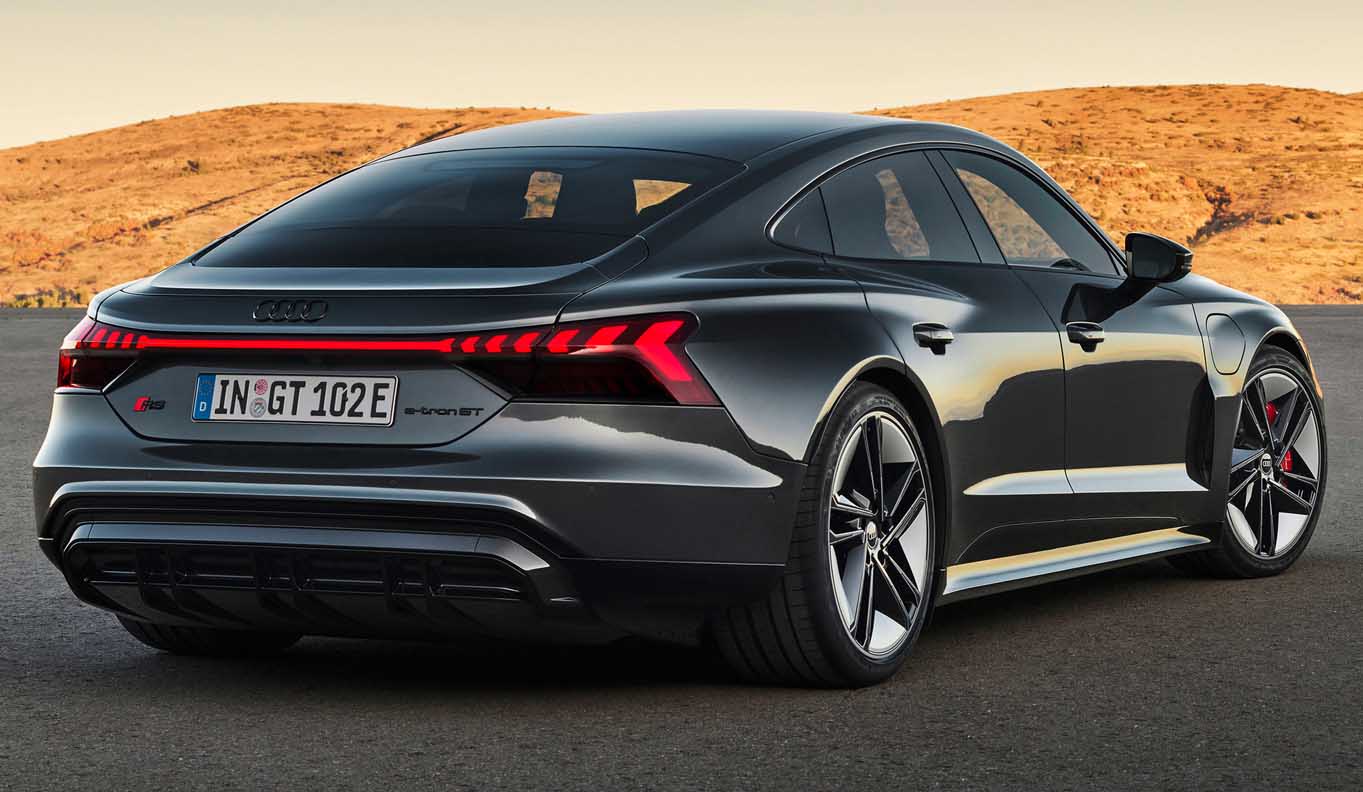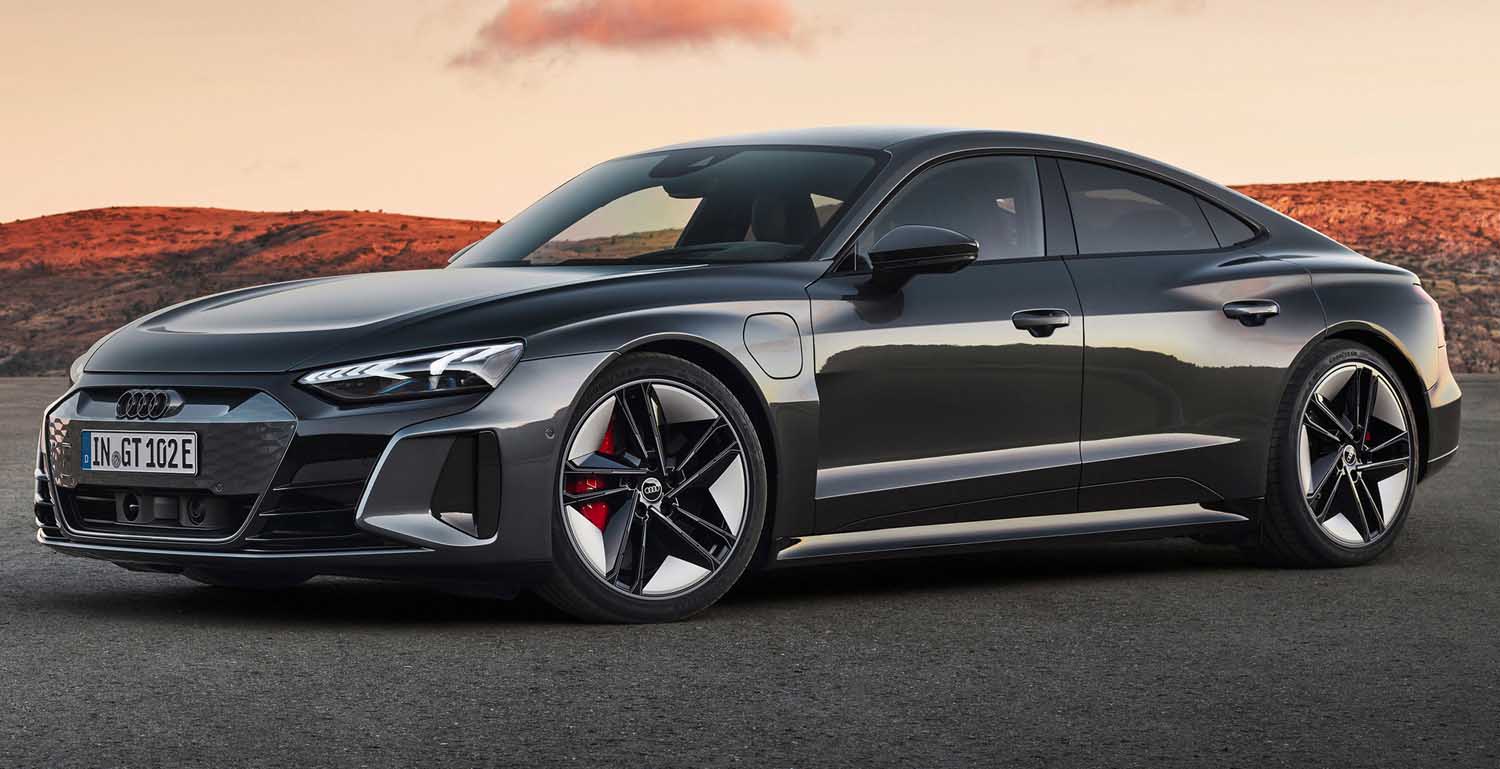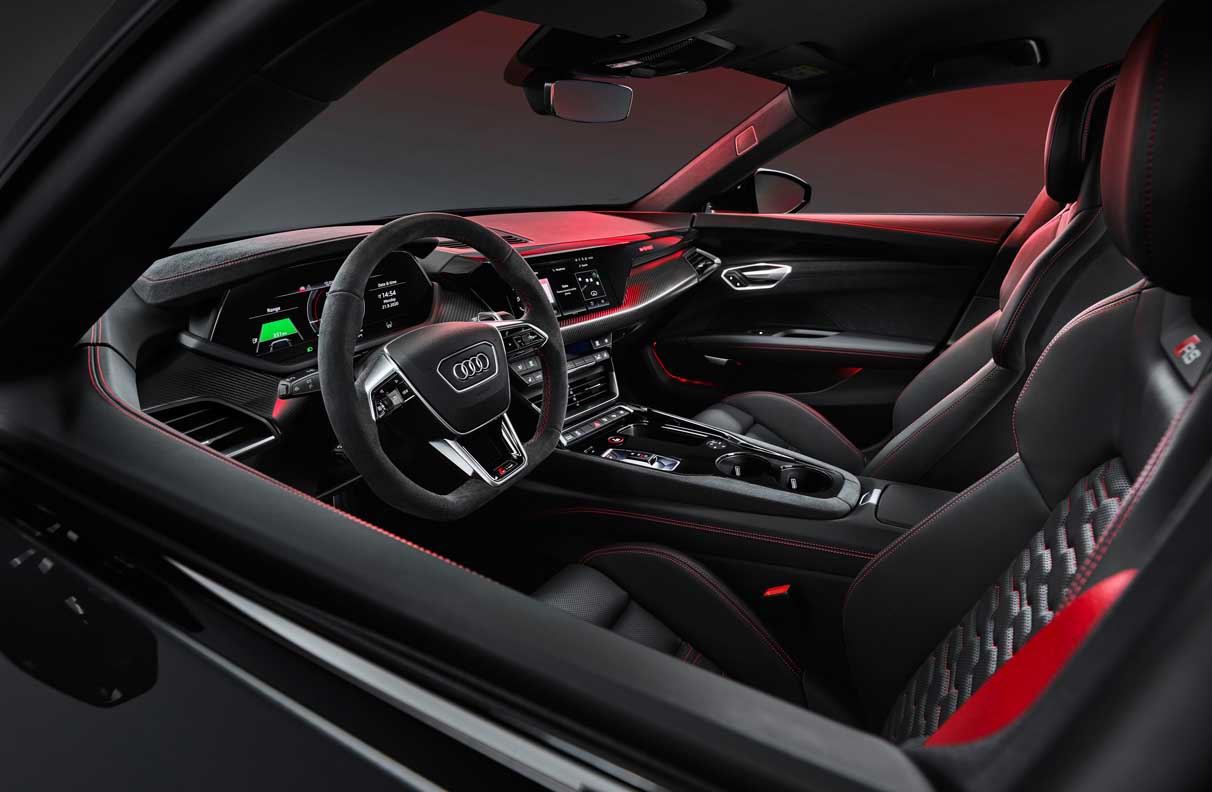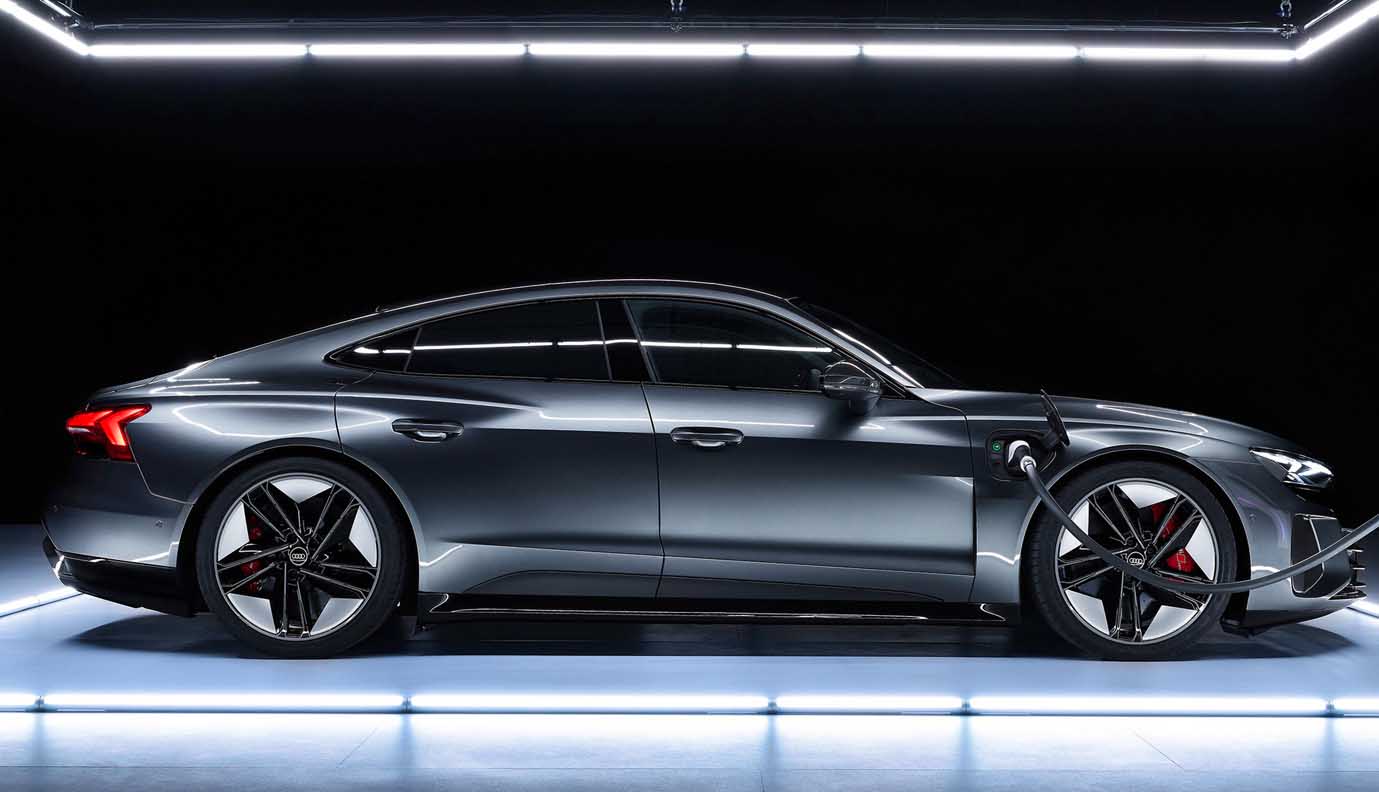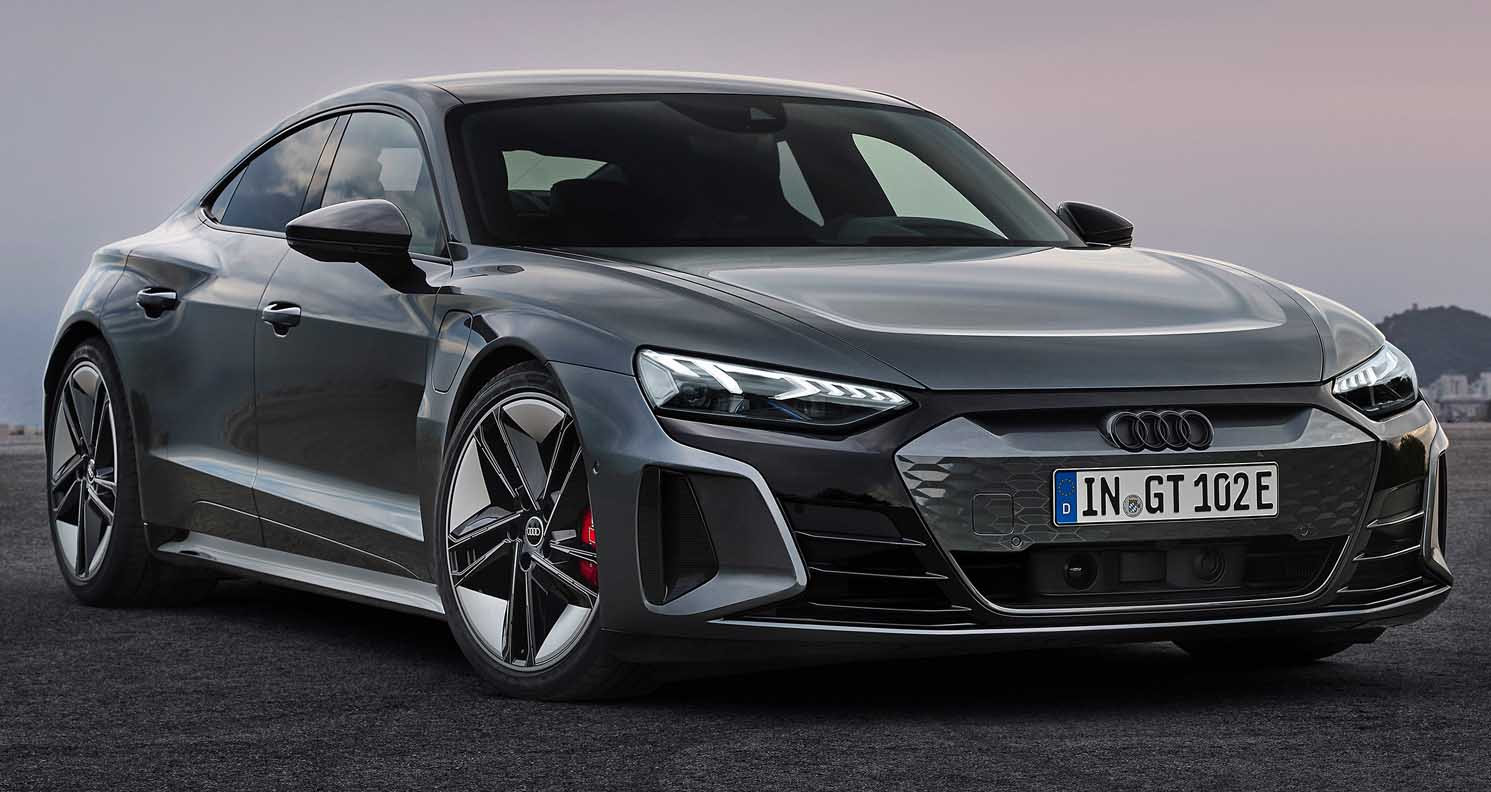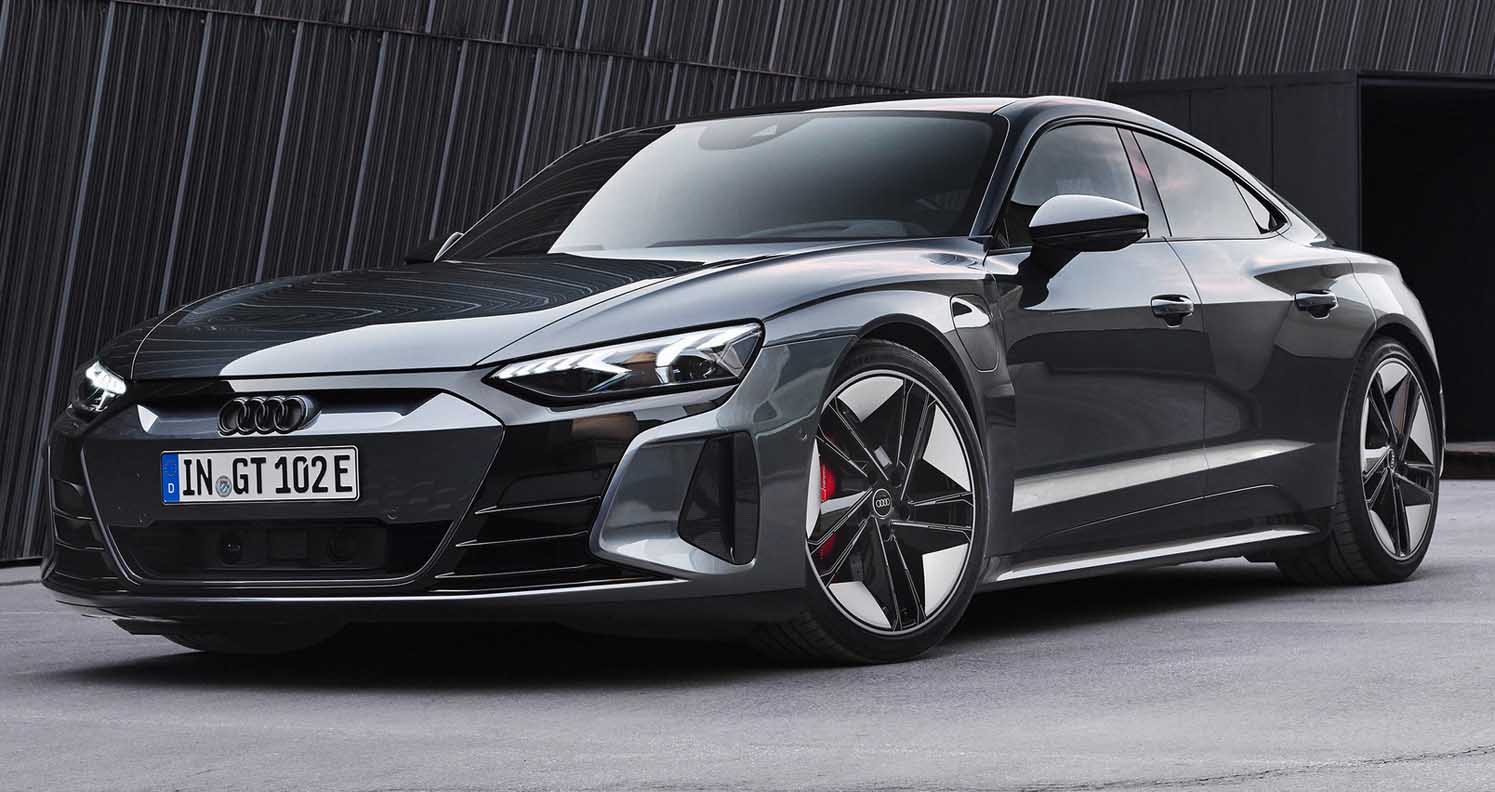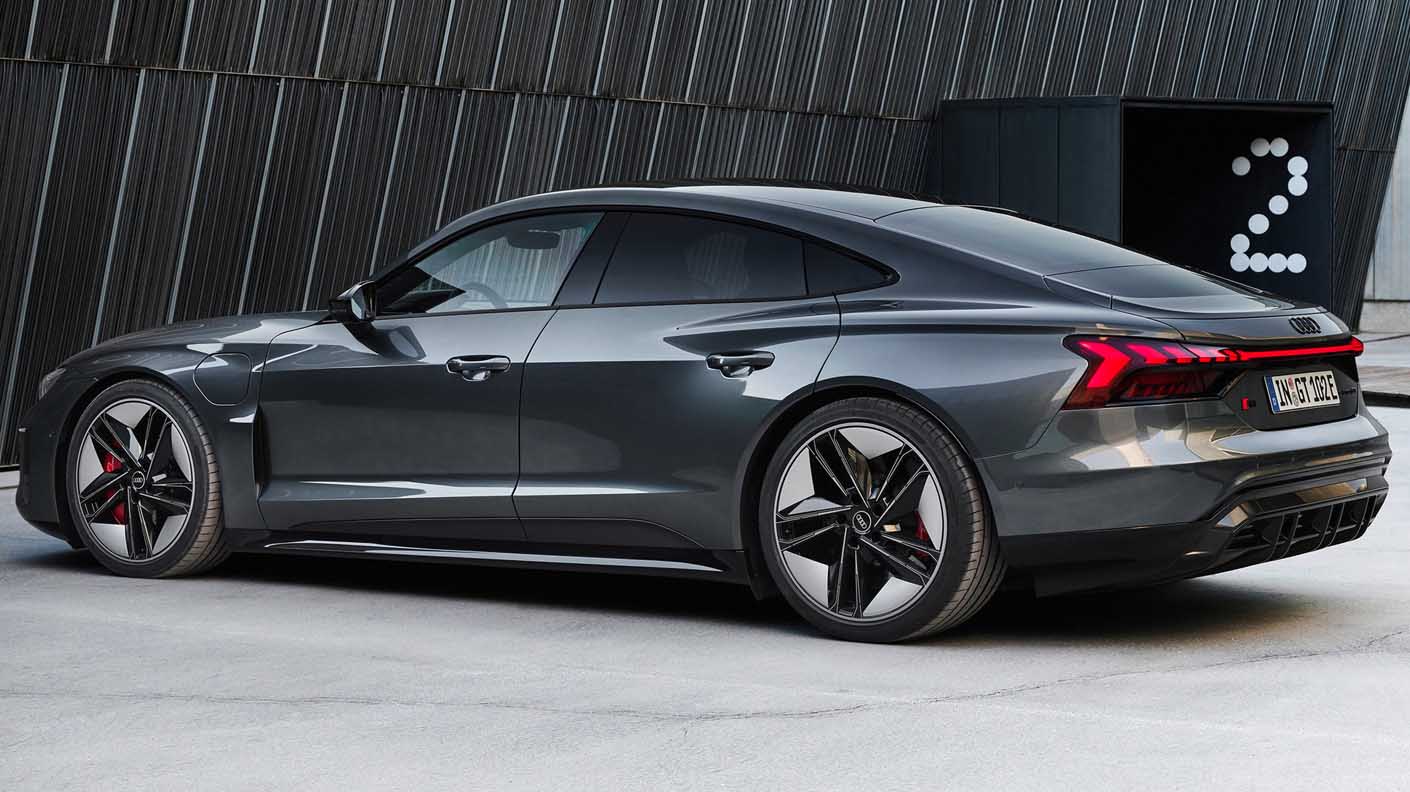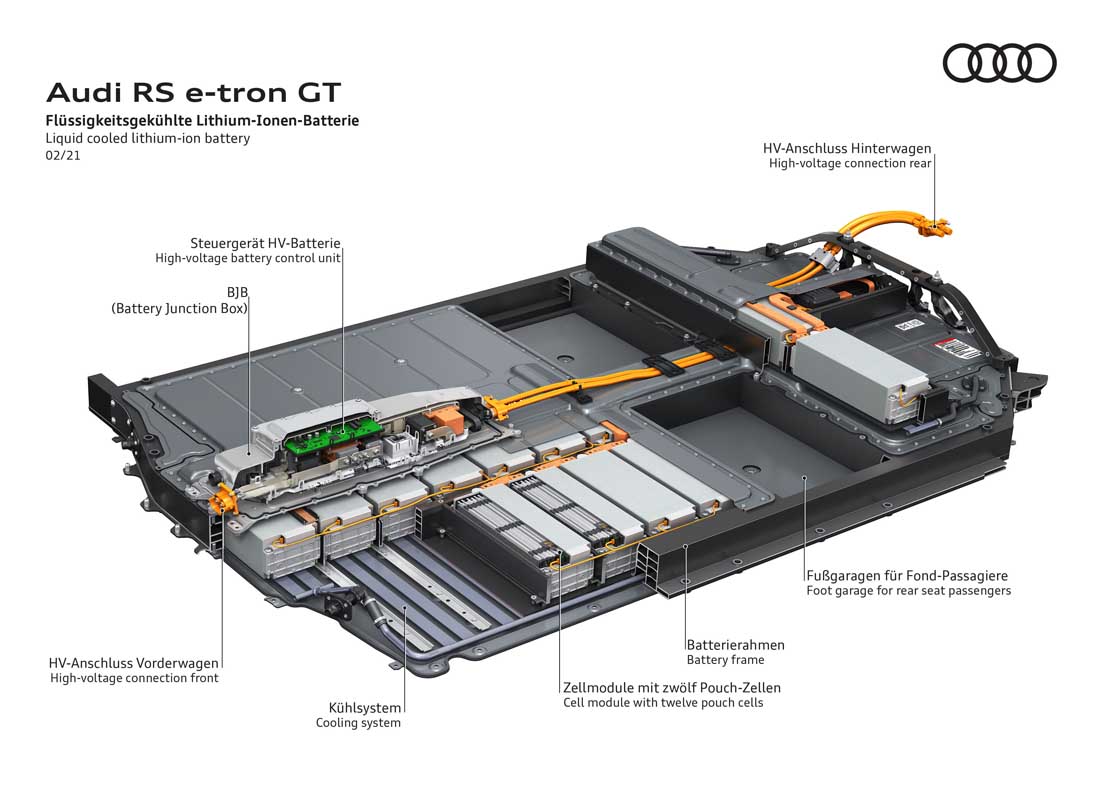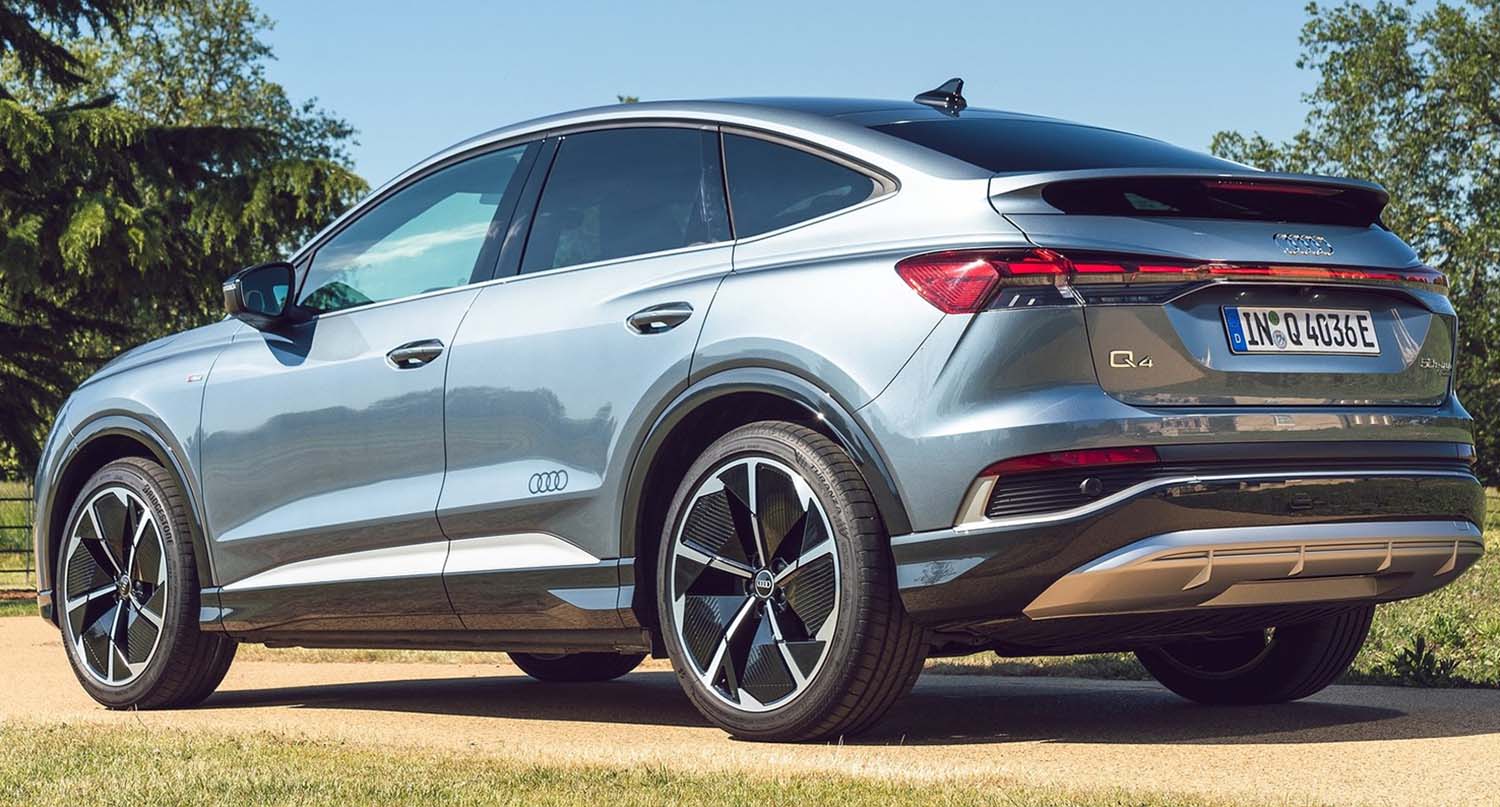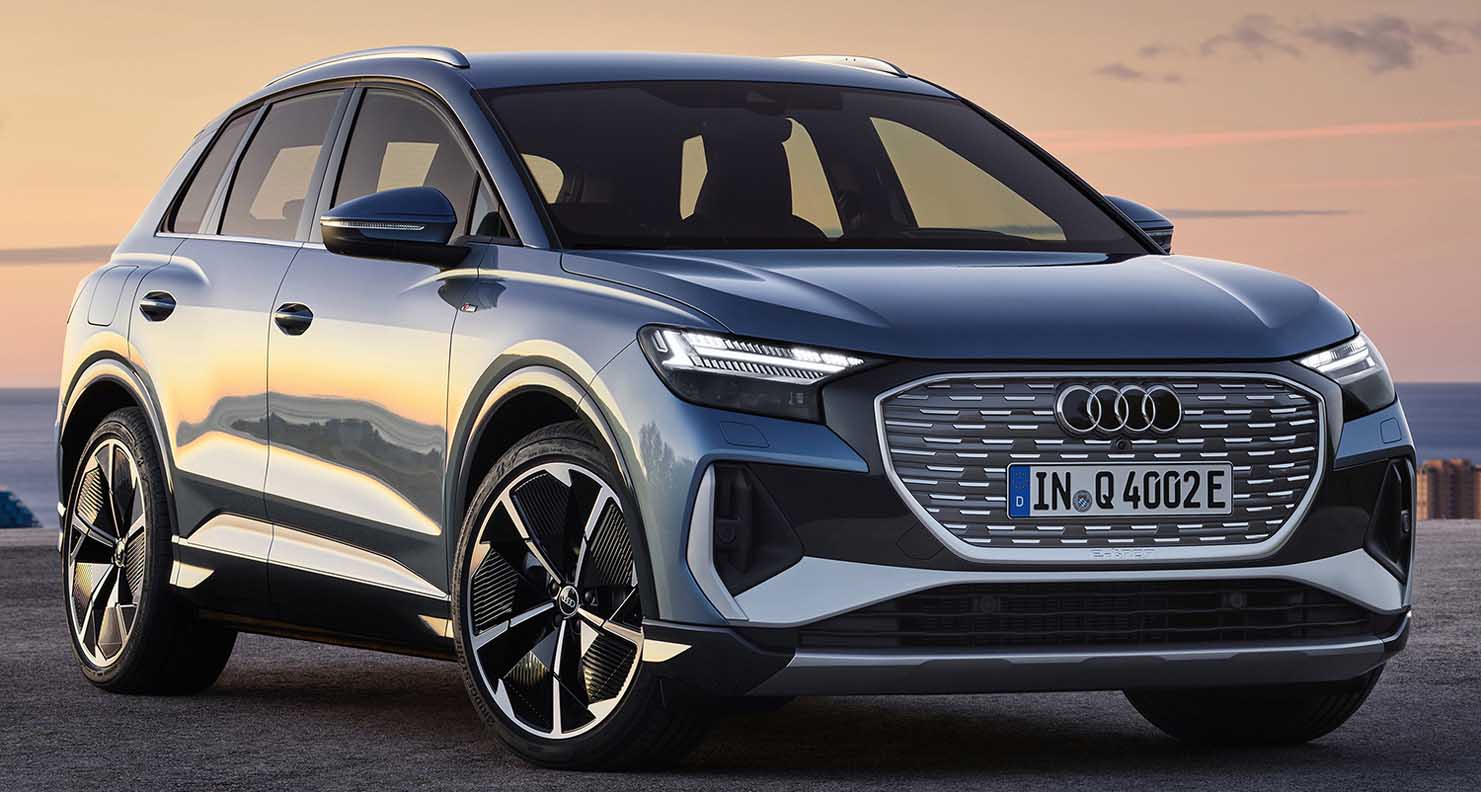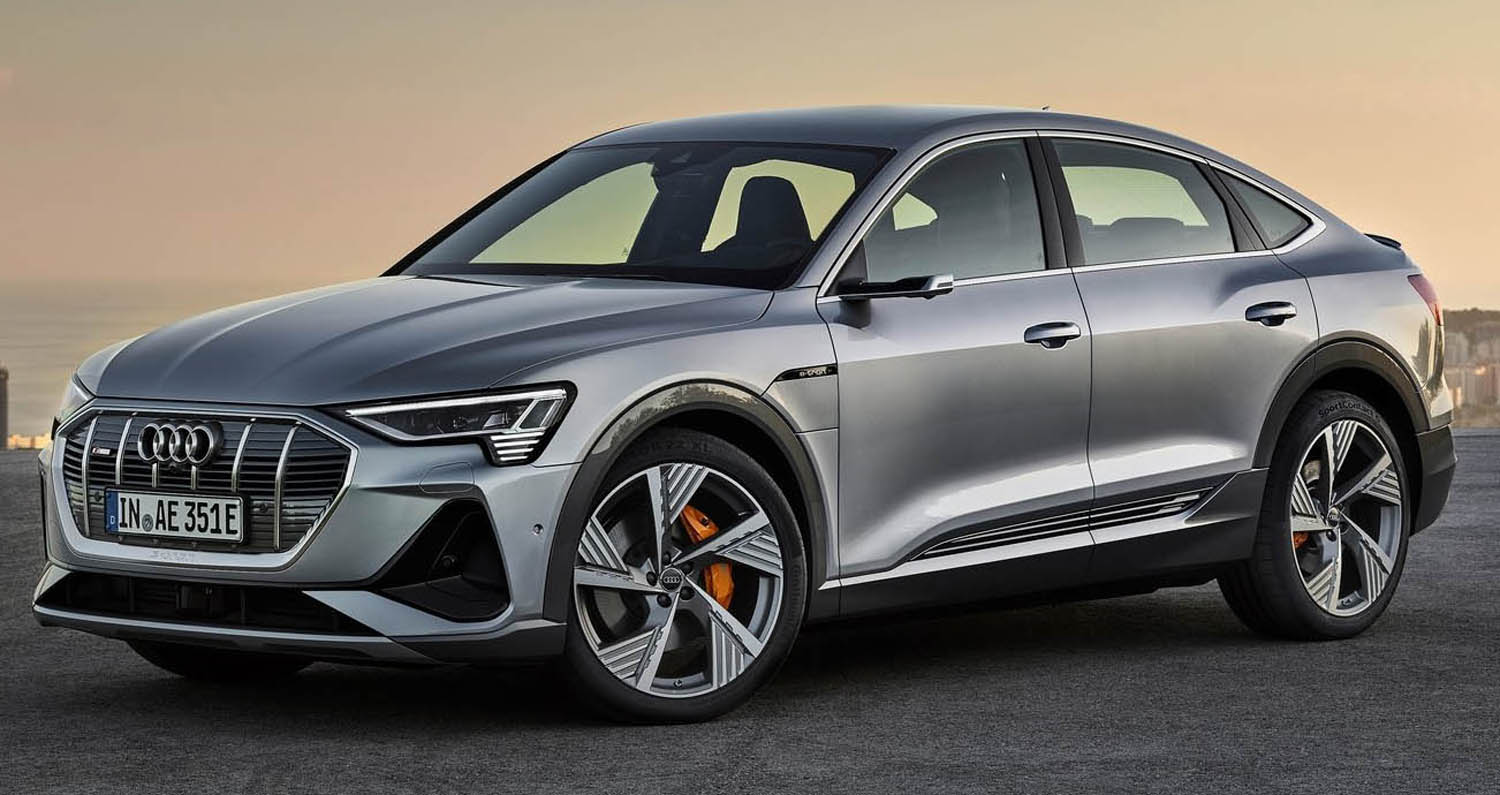
Electric mobility is becoming dynamic and fascinating, as proven by the Audi e-tron GT. The four-door coupé, which will be introduced on the market as an RS model at the same time (combined electric power consumption in kWh/100 km (62.1 mi): 20.2–19.3 (NEDC), combined CO2 emissions in g/km (g/mi)*: 0), reinterprets the classic idea of the gran turismo: Its design is highly emotive, its technology is revolutionary.
Two powerful electric motors provide confident electric all-wheel drive and stunning road performance. The high-voltage battery with a net energy content of 85 kWh enables ranges of up to 487 kilometers (302.6 mi) (for the Audi e-tron GT quattro**) to be achieved and can be recharged extremely quickly thanks to its 800-volt technology. Suspension, lights, controls, connection, or e-tron sport sound: The Audi e-tron GT quattro2 and the RS e-tron GT3 demonstrate accumulated technical expertise and the Audi brand’s passion for details.
With the e-tron GT2, Audi is demonstrating how fascinating electric mobility will be. The four-door coupé combines emotive design with a powerful drive and dynamic handling. This is the start of a new era, the gran turismo of the future.
It is an Audi such as the world has never seen before: With the e-tron GT, the brand is demonstrating its plans for shaping an emotive and fascinating future of mobility. Presales of two models of the gran turismo with fully electric drive will start simultaneously in February 2021: the e-tron GT quattro2 and the RS e-tron GT3. Both models are powerful, fast, and dynamic, and both have zero local emissions. The sum of these qualities adds up to a strong character that reinterprets the idea of the gran turismo.
The exterior of the Audi e-tron GT is a dynamic work of art. Each surface and each line is harmonious, from the headlights, which are available with Audi laser light upon request, to the large diffuser at the rear. In combination, the details create a sculpture that looks like it was shaped by the wind.
The body line is extremely aerodynamic, and the drag coefficient is just 0.24. The interior also corresponds to that of a classic gran turismo: The driver and front passenger seats are installed in a sporty low position and separated by a wide center console, and the rear seats provide sufficient space even for adults. The progressive elegance of the interior design emphasizes the car’s character.
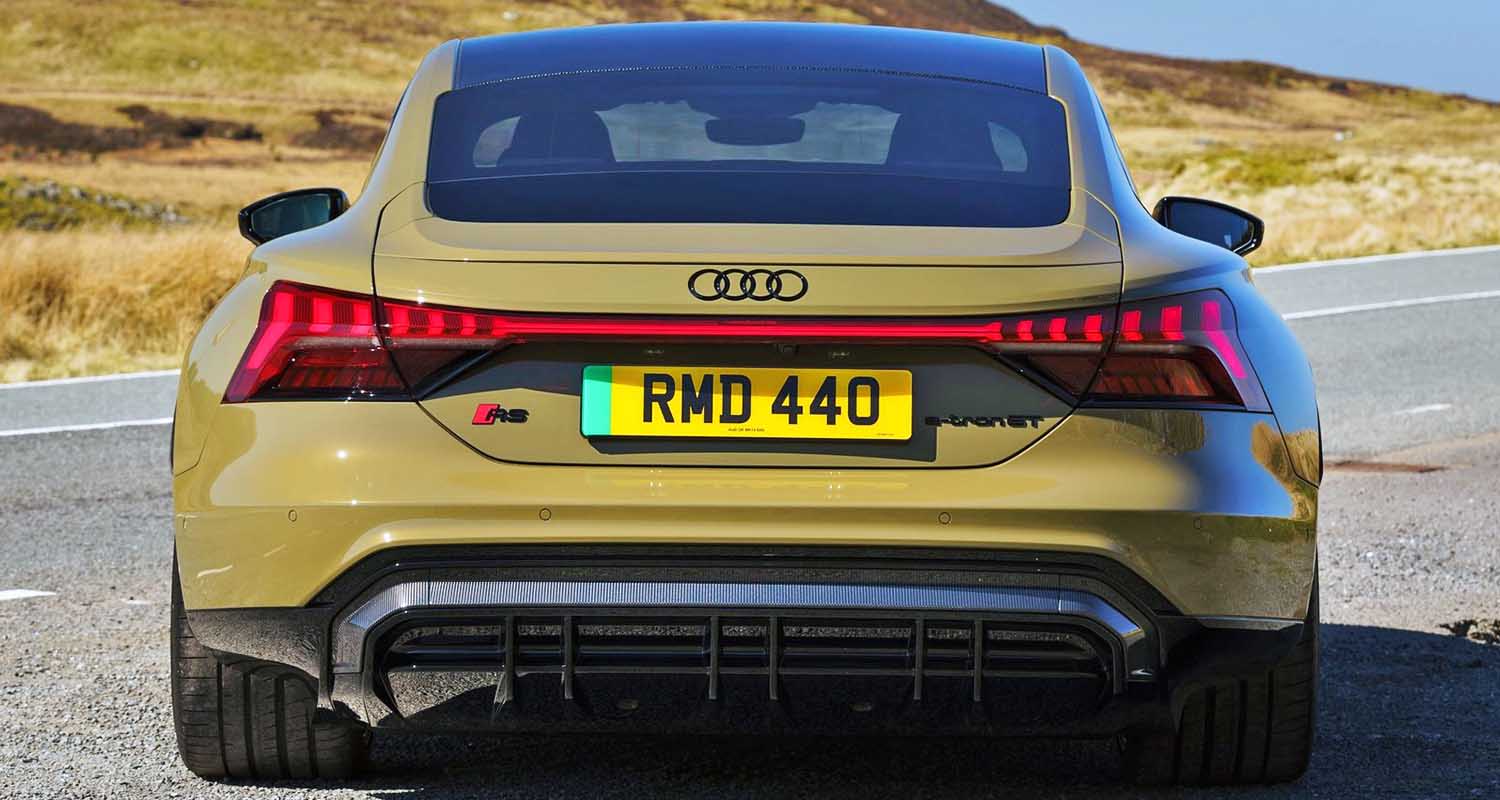
A gran turismo is a sporty touring car with excellent dynamic handling, a confident glider. The Audi e-tron GT shares this character. Depending on the model, its electric motors output 350 kW (476 PS) or 440 kW (598 PS), thereby allowing dynamic spurts. The range of up to 487 kilometers (302.6 mi) (in accordance with the WLTP), which is made possible by the battery and its net capacity of 85 kWh, is equally important.
Its 800-volt technology enables fast DC charging with an output of up to 270 kW. The suspension is also based in the balance of dynamism and comfort, thanks to technologies such as Audi drive select, all-wheel steering, controlled damping, three-chamber air suspension, electric all-wheel drive, and the rear-axle differential lock. The wheel sizes range up to 21 inches, and the brake disks – which are available in carbon-fiber ceramic as an option – have a diameter of up to 420 millimeters (16.5 in).
Like all Audi models, the e-tron GT is connected extensively. The infotainment, the online services from Audi connect, and the assist systems are state-of-the-art. And since the dynamic work of art must also sound good, Audi has composed a unique sound for the e-tron GT. It sounds powerful and progressive – just as an Audi should.
Positioning
The all-electric Audi e-tron SUV and the e-tron Sportback SUV coupé were the pioneers with which Audi embarked on its successful electric mobility journey. Now the brand is making its second statement: The four-door e-tron GT coupé is a gran turismo with dynamic elegance and an Audi such as the world has never seen before. The e-tron GT2 is powerful, sporty, confident, and emotive. It reflects all the passion with which Audi develops and builds cars.
The RS e-tron GT3 and the e-tron GT quattro2 are designed as powerful, confident cars with excellent everyday usability and long-distance capability. They combine perfection, fascination, and innovation to form a technical work of art: Their driving characteristics are founded on progressive engineering skill, the drive is pure fascination, and the design arose from the passion for beauty and perfection that is typical for Audi.

Sporty, electric, pioneering: The e-tron GT is the electric figurehead from Audi
The Audi e-tron GT2 represents yet another chapter in Audi’s history: It is a supreme gran turismo, and the RS version3 comes with particularly pronounced dynamic handling. It combines an expressive design language with powerful electric output, high efficiency, and excellent everyday usability. These properties make it a pioneer full of character that is shaping the future of the brand. The e-tron GT brings “Vorsprung durch Technik” to the road and emphasizes the Audi standard as the company’s electric figurehead: sporty, electric, and pioneering.
The Audi e-tron GT is targeted in particular toward sophisticated, performance-oriented car enthusiasts who attach great value to sustainability, design, and high-tech. The majority are middle-aged and well educated, which is why they have a high monthly income and can afford multiple vehicles. They share their passion for sophisticated acceleration and their love for detail, as well as maximum precision and top quality with Audi.
In February of 2021, presales of two versions of the fully electric gran turismo will start in Europe: as an Audi e-tron GT quattro2 with a base price of EUR 99,800 and as an RS e-tron quattro3 from EUR 138,200. The RS model is the dynamic spearhead of electric mobility at Audi: a system output of 440 kW (598 PS), 0–100 km/h (62.1 mph) in 3.3 seconds (in overboost), and a high-tech suspension with features such as three-chamber air suspension, all-wheel steering (optional), and controlled rear axle differential lock.
Exterior design and aerodynamics
The e-tron GT is an emotive four-door coupé and the new signature car from the Audi brand. The electric figurehead features expressive design language that emphasizes the Audi standard of being an innovative automotive design brand that stands for sportiness and progressiveness.
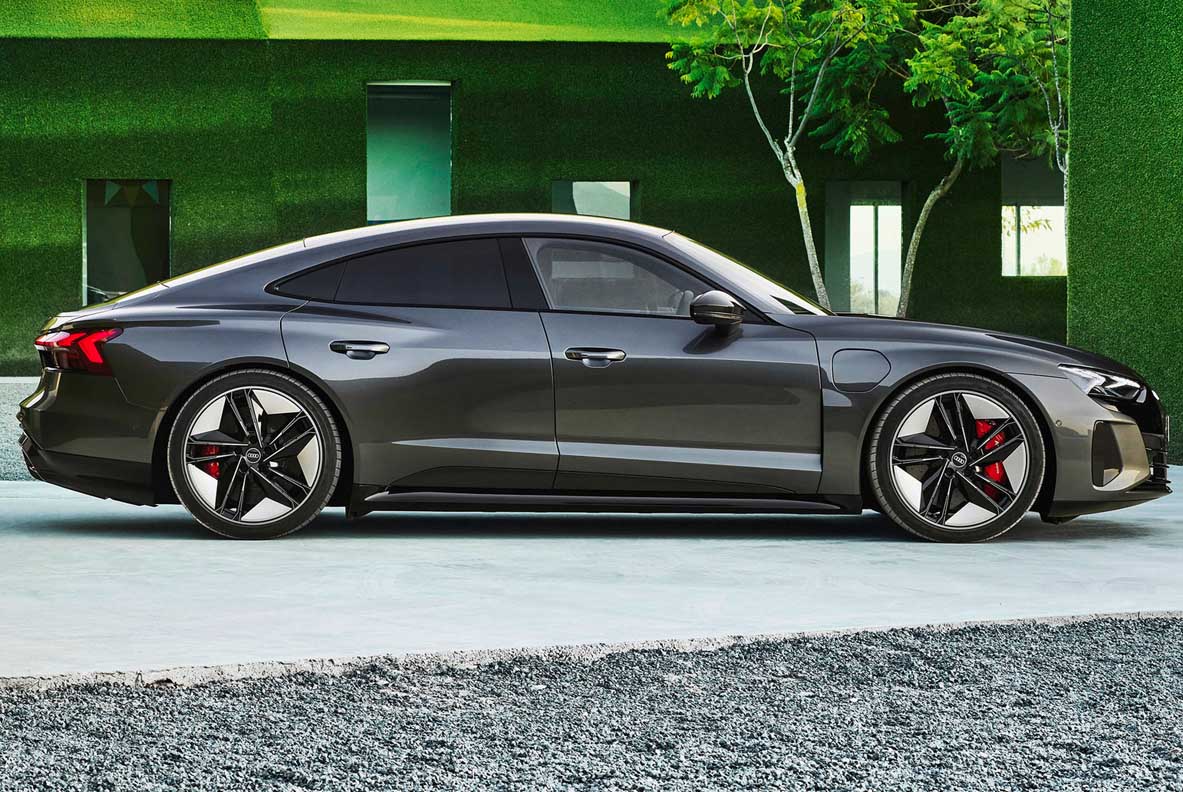
Meaning: emotive signature car and preview of future design
Following the Audi prologue design study, which offered a preview of the design language of the subsequent full-size class models as a show car in 2014, the e-tron GT constitutes the next evolutionary stage of the Audi design language. As a gran turismo, it fascinates with its sculptural design. What applies for the current full-size class models applies here, too: Proportions are the foundation of good design. In other words: a long wheelbase, wide track, large wheels, and a flat silhouette. The e-tron GT has precisely these ideal proportions. Its design language is the starting point for the design of future electric models from Audi – they will have a significantly more flowing exterior design than today’s models.
As is always the case at Audi, the design is not an end in itself but rather the connection between form and function: In line with electric mobility, the design of the e-tron GT,enables sophisticated aerodynamics – aesthetics thus also arise from efficiency. The e-tron GT deliberately adopts established design elements of the e-tron, the first electric car from Audi, and refines them in a targeted manner. These elements include the strongly modeled insert above the door sill trims. It emphasizes the battery pack in the center of the vehicle as the car’s powerhouse.
Electric gran turismo: classic principles and a new perspective
Sportiness and comfort – these are the two classic design principles of a gran turismo. The design of the Audi e-tron GT2 takes up this idea and adds a new perspective to it: Sustainability plays an important part in electric mobility in particular.
It begins with the initial idea and is expressed through the design. The optimized aerodynamics of the e-tron GT are visible proof of the pursuit of sustainability. Its low drag coefficient of 0.24 increases the level of efficiency and enables a longer range.
These basic ideas are also found in the interior of the e-tron GT. For example, the dashboard – which is turned toward the driver as is typical for sporty Audi models – rests within a spacious interior design that is characteristic for a comfortable and dynamic touring sports car. At the same time, the e-tron GT demonstrates with its leather-free design package, which consists predominantly of recycled materials, that sustainability is an important aspect of the electric gran turismo.
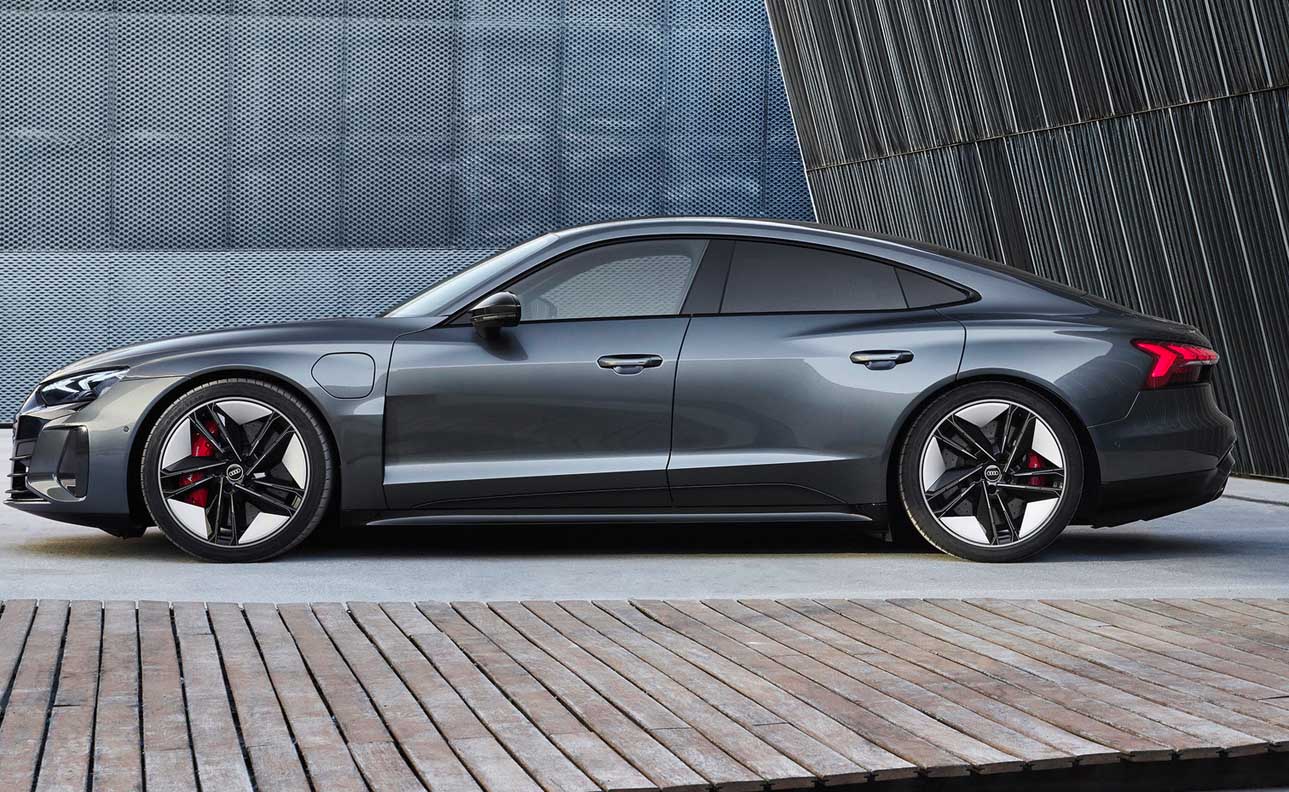
Exterior design: dynamic sculpture with perfect proportions
The fully electric gran turismo gives new impetus to the Audi design language: It is a dynamic sculpture that stands on the road as if sculpted from a full volume. The Audi e-tron GT2 is proof: The packaging of an electric car with its large battery and the fascinating design of a gran turismo with a flat silhouette and powerful proportions need not be mutually exclusive. This is made possible by a recess in the battery pack.
The passengers in the rear can put their feet in what is known as the foot garage, which allows them to sit in a lower position and enjoy generous headroom despite the flat roof line. In combination with the wheel arches with up to 21-inch rims and the 2.90-meter (9.5 ft) wheelbase, this solution creates ideal proportions and gives the high-performance GT an extraordinary presence on the road.
With its inverted color scheme, the Singleframe with the Audi rings on the expressively designed front of the e-tron GT is a clear indicator for the electric drive. The radiator grille, which reinterprets the classic honeycomb pattern, is painted in light Heckla gray or in body color for the first time at Audi, and the grille and lateral air inlets are framed by a mask in dark Manhattan gray. While the main purpose of the Singleframe on models with a combustion engine is to cool the engine, it conceals the majority of the sensors in the e-tron GT. Only the lower of the six corners have open sections for air supply.
The technology packaging of the electric drive allows for a flat front end, thereby providing the driver with a fascinating view over the front end and directly onto the road. This view is focused due to the fact that the hood is framed by strongly curved fenders on both sides. This unusual perspective and the dynamism of the drive create a driving experience that shapes the character of the electric gran turismo to a great extent.
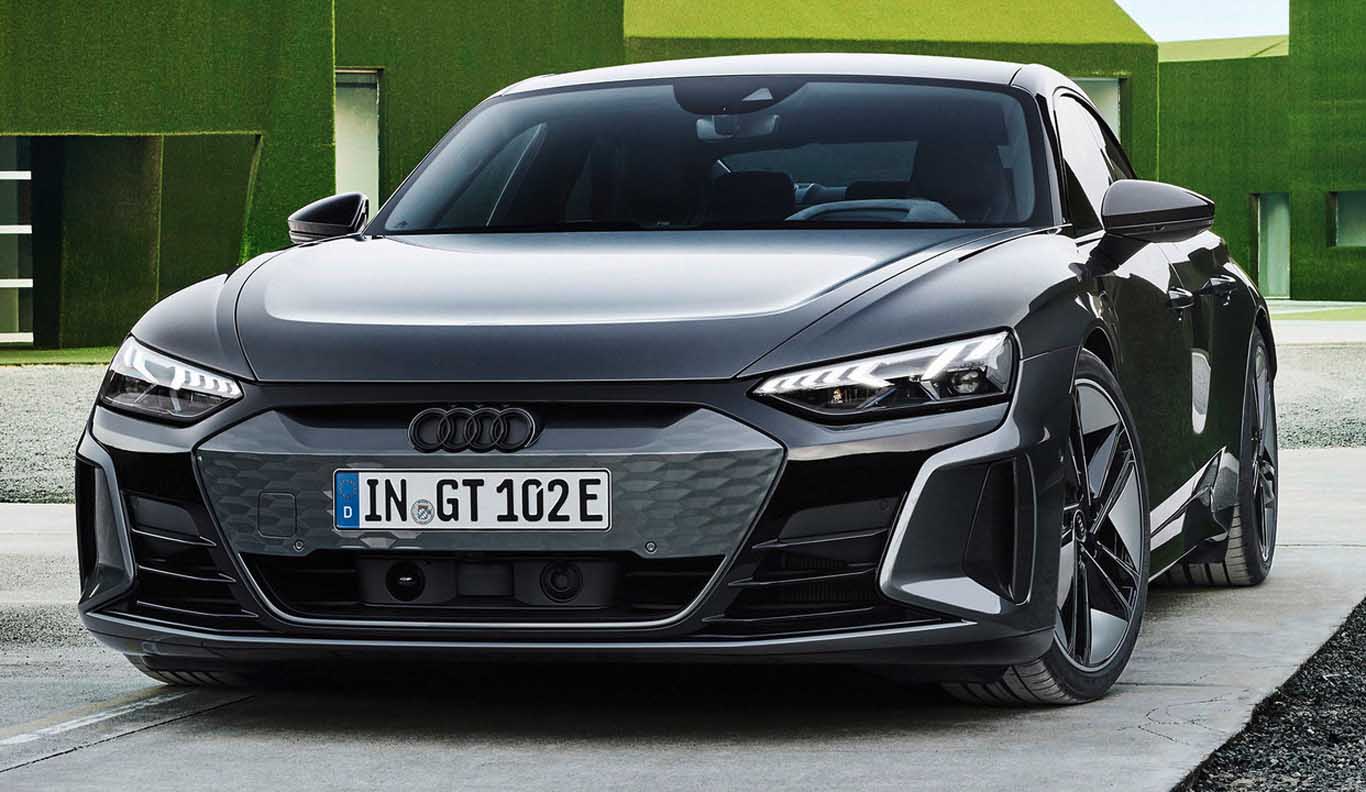
Side view: a flow of lines
The flow of the design is very obvious in the side view in particular. The elongated hood and flat windshield transition into a quickly sloping roof line. The greenhouse thus extends tautly over the powerful body. It is drawn in sharply toward the rear – the gently inclined C-pillars in the rear area flow elegantly into the muscular shoulders of the body.
Sharp edges extend across the large wheel arches – these quattro blisters with the pronounced sculptured wheel arches symbolize the electric all-wheel drive. They are a stylistic feature of many Audi models, but nowhere else are they as strongly pronounced as here. The quattro drive is further emphasized by the combination of a low center of gravity in the main body section and the pronounced tapering at the car’s midsection. The lean, elongated “Sportback” cabin is positioned on the body: With its flat roof line, which is another 17 millimeters (0.7 in) lower than on an A7 Sportback, it emphasizes the sporty body line of the e-tron GT.
The lights at the rear are connected by a flat light strip. A visually offset diffuser gives the e-tron GT2 an unmistakable look within the Audi product portfolio. The spoiler with the integrated spoiler lip runs parallel to the light strip and rounds out the sporty look.
19- to 21-inch rims highlight the powerful design and already hint at the sporty capabilities of the e-tron GT while the vehicle is stationary. The color palette comprises nine colors, including the new color tactical green. Audi can provide two variants of the black styling package upon request. The first variant comprises the Singleframe, its mask, the area of the sills and door inserts, and the diffuser. The black styling package plus comes with the rings and badges in black gloss in addition. The three different carbon packages are even more exclusive. Audi can also provide the housings of the exterior mirrors and the entire roof in carbon fiber-reinforced polymer (CFRP) upon request. As standard, the roof is made of heat-insulating glass.
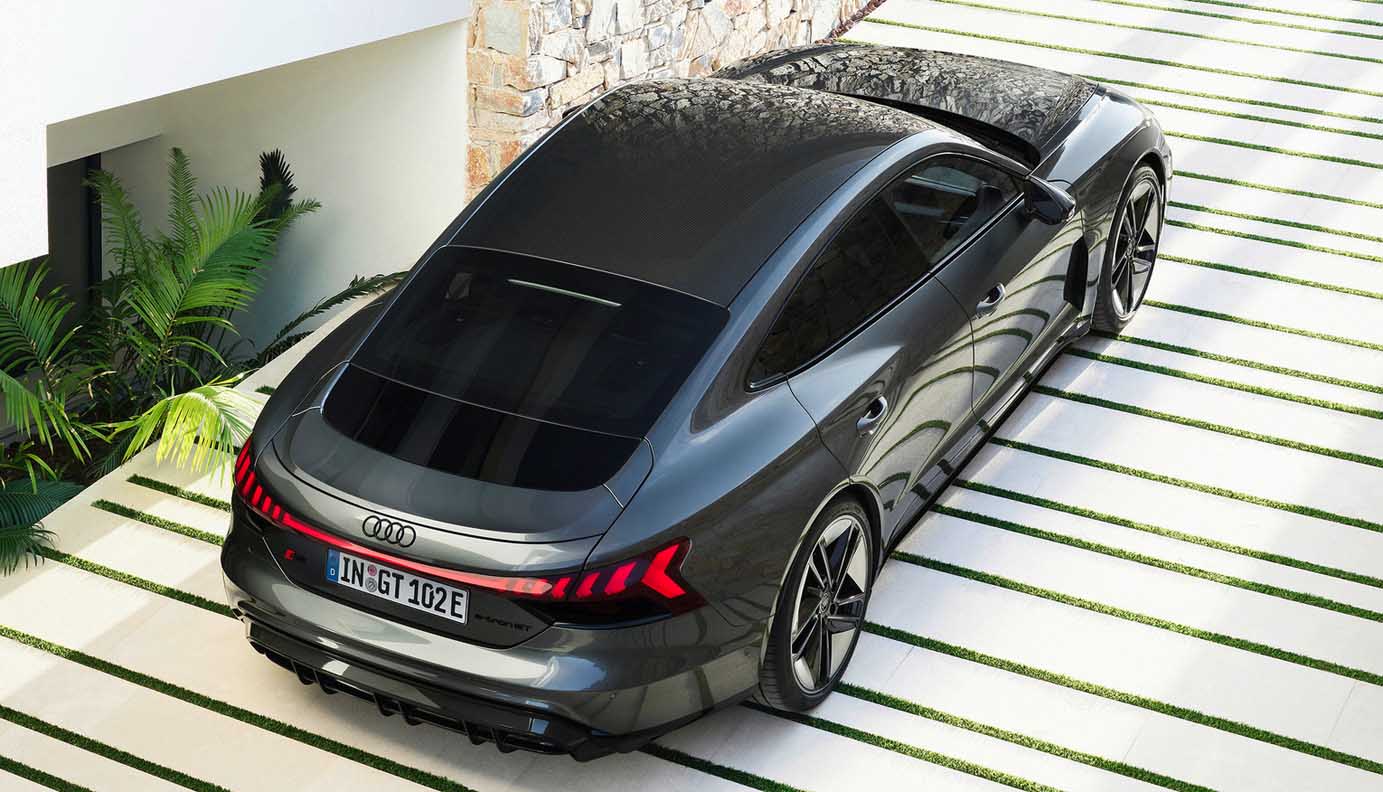
Team work: Design meets aerodynamics
Aerodynamics isn’t just the means to an end in the e-tron GT2 but an important design feature. The design with its drag coefficient of 0.24 looks as if it were shaped by the wind – and it is. It was developed in close collaboration between designers and aerodynamics engineers.
The air inlets in the lower section of the front play an important role. The exterior upright air curtains guide the air into the wheel arches such that the air flows close to the wheel and then along the side. Some of the 20- and 21-inch rims feature light aero blades that are just 2 to 3 millimeters (0.08–0.12 in) thick. This covering further increases aerodynamic efficiency.
There is one controllable cool air inlet each behind the large ribs below the headlights and behind the openings in the corners of the Singleframe, which ensures active aerodynamics. In the interest of efficiency, the two controllable cool air inlets remain closed as much as possible. When they open in the context of a dynamic driving style, Y-shaped channels send the air to the coolers and into the front wheel arches in order to cool the brakes there.
The second major factor in the concept of active aerodynamics is the rear spoiler, which extends electrically to two different positions, depending on the speed. It works together closely with the smooth underbody that ends in a wide diffuser. This allows the air to flow cleanly off the rear end, and the lift that occurs at the rear axle at high speeds is almost fully compensated. When the adaptive air suspension (standard in the RS model3 ) lowers the body, it increases this effect, further improving the air flow and handling stability and further reducing lift.
The e-tron GT2 is also top-class when it comes to aeroacoustics. Its windshield is made of noise-insulating glass as standard, and the side windows are rear window are available with this type of glass upon request. Targeted insulation measures throughout the entire body keep annoying noises out of the interior. Parts made of hot-shaped and therefore ultra-high strength steel form the strong backbone of the passenger cell. The battery housing consists of aluminum profiles, and the outer skin is made entirely of aluminum sheets.
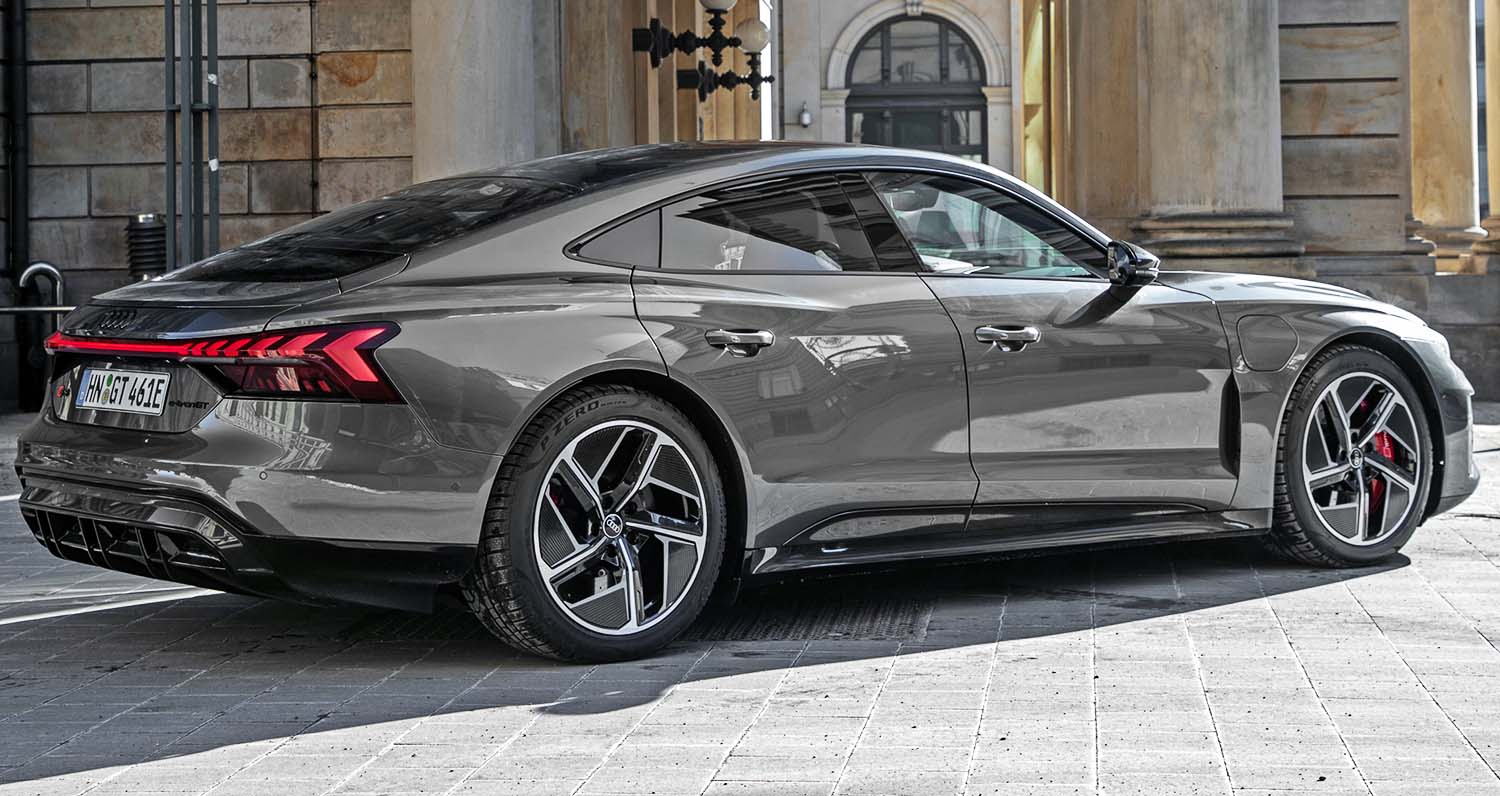
Dimensions: gran turismo par excellence
The Audi e-tron GT2 has the dimensions of a classic gran turismo: With a wheelbase of 2.90 meters (9.5 ft), it measures 4.99 meters (16.4 ft) in length, 1.96 meters (6.4 ft) in width, and just 1.41 meters (4.6) in . The luggage compartment offers 405 liters (14.3 cu ft) of capacity, while the RS model3 with the standard premium sound system from Bang & Olufsen offers 366 liters (12.9 cu ft). A second luggage compartment below the front hood offers a further 85 liters (3.0 cu ft) of space.
Headlights and lights
The headlights and rear lights are characteristic elements of the exterior design of the e-tron GT2 that further enhance the expressive exterior design. The LED light signatures at the front and rear feature pronounced three-dimensional modeling and emphasize the emotive look of the e-tron GT. The daytime running lights provide a striking light signature, together with the characteristic blue designer trim of the optional Audi laser light that is at the center of the headlights at Audi for the first time. The sculptural light strip at the rear spans across the entire vehicle width, changing dynamically from a line in the center into ever larger segments toward the outside, which makes the e-tron GT appear even more powerful.
Three variants of headlights are available for the e-tron GT. Audi supplies them in LED technology with dynamic turn signals as standard. The Matrix LED headlights are available as an alternative. Their continuous high beams can shine with maximum brightness without causing glare to other road users. They come as standard with the RS e-tron GT3. Topping the range are the Matrix LED headlights with Audi laser light.A laser spot is installed next to the low beam module. The laser spot is activated from a speed of 70 km/h (43.5 mph) and doubles the range of the high beam.
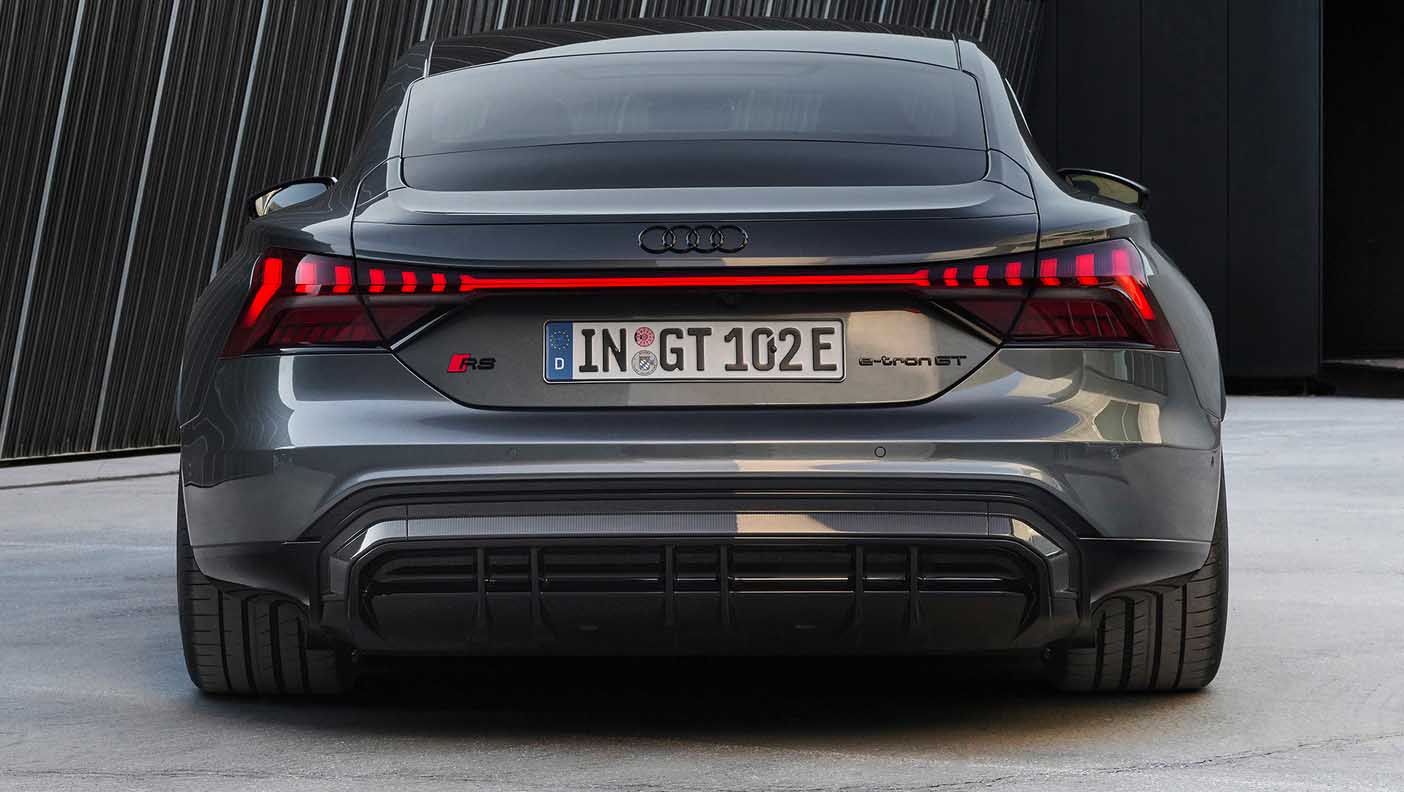
Coming home and leaving home animation: character made visible
The top-of-the-line headlights offer another characteristic feature: coming home and leaving home animations at the front and rear. The leaving home sequence is inspired by the power of a sound wave: The illumination of the individual elements builds up quickly and strongly, then retreats briefly before going all in the second time. All the animations in the RS model3 are even more dynamic.
Interior design and interior
The interior of the e-tron GT2 conveys the ultimate gran turismo feel by radiating sportiness, comfort, and expanse in equal measure. Sustainable materials also play an important part in the electric sports car.
Interior: sporty and luxuriously comfortable
The strong focus of the interior on the driver, inspired by the monoposto idea, is a characteristic of sporty Audi models and the e-tron GT in particular. The central dashboard is tilted slightly to the left, and the pronounced three-dimensional instrument panel looks light and lean. Its upper section is drawn away from the driver in a large, elegant arc. The display of the Audi virtual cockpit plus stands freely in this space, while the MMI touch monitor is surrounded by a black piano finish bezel that seems to float above the instrument panel. If the ambient lighting package plus is on board (standard in the RS model3 ), it features a lasered and backlit “e-tron” badge in the right-hand section.
A strong contour separates the upper section of the instrument panel from the lower section, which contains the control panel of the standard three-zone automatic air conditioning system. The flat lateral air vents have a decidedly technical look and underline the width of the interior, with aluminum brackets surrounding their ends. A long arc below the windshield extends from one door to the other. The design of the sporty front door trims visually merges in a straight line into the fender edges of the front section.

The driver and passenger sit in a sporty low position, separated by a wide center console. The compact selector switch for the gears is located on the center tunnel console.
Its lean design emphasizes the airy sense of space and provides a highly precise haptic control experience. The rear seats offer sufficient space even for adults. The uncompromisingly high quality and processing of the materials reflects the attention to detail with which Audi develops and builds cars.
Sustainability is the new premium: materials, colors, and equipment
Sportiness and sustainability do not contradict each other; in combination, they characterize the understanding of luxury in the course of electric mobility at Audi. The e-tron GT2proves this with its leather-free design package. The sport seats plus with 14-way adjustment are upholstered either with a combination of artificial leather and the Kaskade material or with a mixture of artificial leather and the microfiber material Dinamica. Recycled materials are used in both cases, for example polyester fibers that were made from old plastic bottles, or textiles, or residual fibers from selvages. There are 119 recycled plastic bottles in each Kaskade upholstery set. The Dinamica material is similar to Alcantara, while the Kaskade material, whose seam design is based on the look of the Singleframe, is reminiscent of natural fibers such as wool.
The upholstery of the sport seats pro is made of a combination of two types of leather. The RS design package comprises microfiber material on the hood of the instrument panel carrier, the steering wheel, and the center console trim, with red or gray stitching adding highlights. The floor carpet and floor mats are made from Econyl in both models. This material consists of 100-percent recycled nylon fibers from production waste, fabric and carpet remnants, or old fishing nets.
All materials in the interior of the e-tron GT2 are processed in factory-level quality. The large application area on the instrument panel is painted in graphite gray or palladium silver (on the RS model3 ) as standard; open-pore walnut wood decor or silk matt carbon are available as an alternative. The ambient lighting package plus (optional with the e-tron GT quattro, standard with the RS e-tron GT) adds subtle light effects, including on the loudspeaker bezels in the doors. The “e-tron GT” logo is projected onto the ground when the driver’s door is opened. In the RS e-tron GT, design elements, colors, and materials from Audi Sport underline the high performance standard.
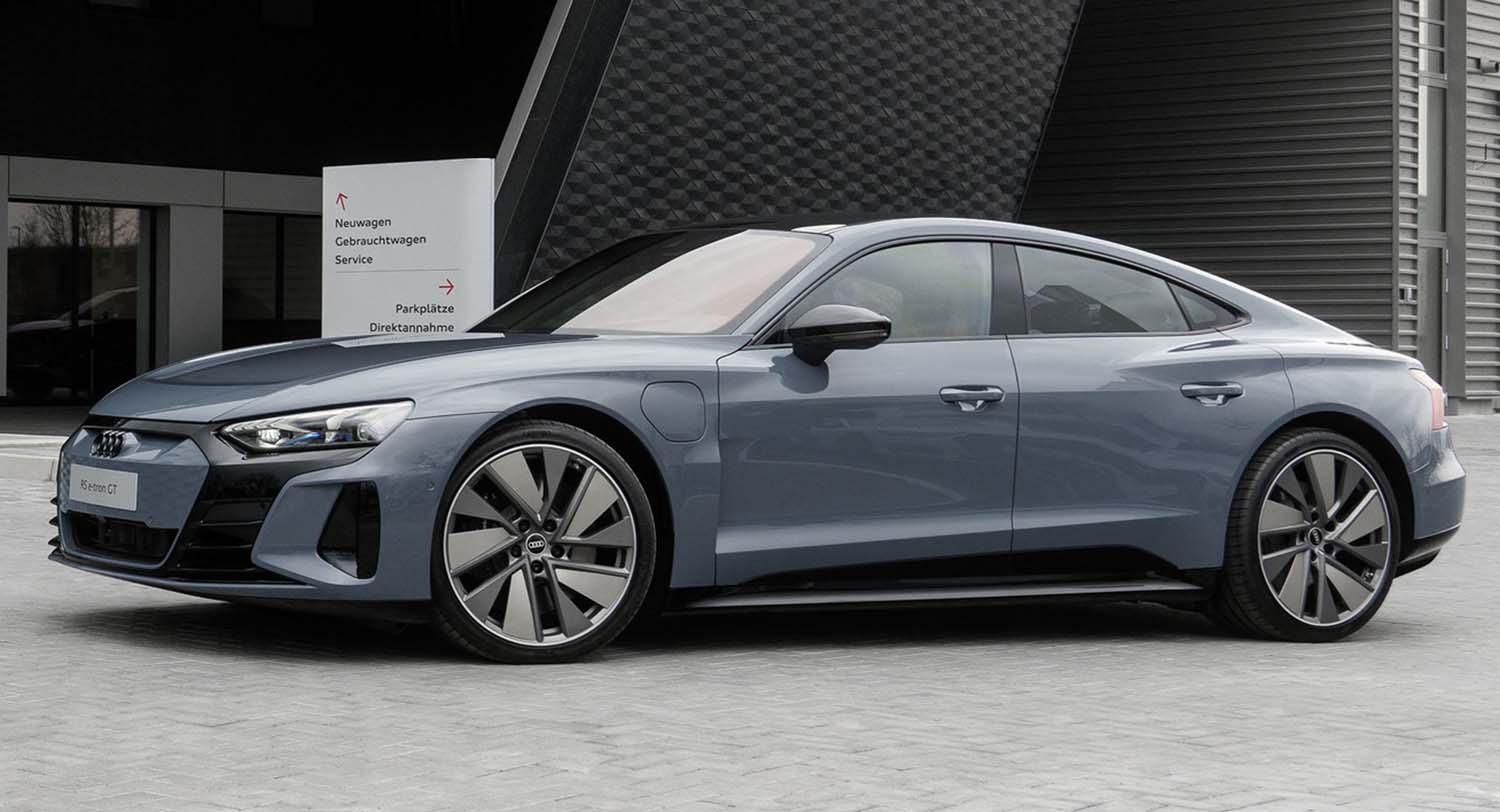
The front seats are available in three versions. The sport seats with electric eight-way adjustment and artificial leather/pearl Nappa leather covers are standard in the e-tron GT quattro2. The RS e-tron GT3 is equipped with sport seats plus with 14-way adjustment and seat heating. The sport seats pro with 18-way adjustment, pneumatically adjustable side bolsters, climate control, and (upon request) a massage function are available as an option for both models. In both seat variants, a bezel in the area of the head restraint further sharpens the sporty contour. The seats and steering wheel of the RS model feature special badges, and the pedal caps and footrest are made of stainless steel. The Audi exclusive program from Audi Sport GmbH fulfills many personal customer requests, in particular with regard to leather, stitching, and seat belts.
Drive and recuperation
The purely electric gran turismo from Audi offers dynamic performance in both engine versions: The e-tron GT quattro2 accelerates from zero to 100 km/h (62.1 mph) in 4.1 seconds, while the RS model3 takes 3.3 seconds (in boost mode in each case). The top speed is 245 km/h (152.2 mph) and 250 km/h (155.3 mph) (governed), respectively.
In the e-tron GT quattro2, the front electric motor outputs 175 kW (238 PS), and the rear motor outputs 320 kW (435 PS). Both electric motors keep reserves available for extreme driving situations, which is why the sum of their individual outputs exceeds the drive’s total output of 350 kW (476 PS) considerably. Up to 390 kW (530 PS) are available for approx. 2.5 seconds in boost mode via launch control. The total torque is 630 Nm (464.7 lb-ft), in boost mode 640 Nm (472.0 lb-ft). In the RS e-tron GT3, the electric motor at the front axle also outputs 175 kW (238 PS), while the motor in the rear outputs 335 kW (456 PS). The total output is 440 kW (598 PS), and the total torque is 830 Nm (612.2 lb-ft). In boost mode, the output briefly increases to 475 kW (646 PS).
The PSM motors (permanently excited synchronous motors) in the e-tron GT work with great efficiency. The electric motor, its power electronics, and the transmission form a compact block on both axles. The rear electric motor transfers its torques to a two-speed transmission. The close-ratio first gear ensures spirited acceleration right from the start, if the driver so desires. If they choose not to use first gear, the e-tron GT moves off in second gear. Generally speaking, the long-ratio second gear improves efficiency and also provides large amounts of reserve power.

quattro reloaded: electric all-wheel drive
The e-tron GT quattro2 and the RS e-tron GT3 usually drive with electric all-wheel drive, with only the “efficiency” mode of the Audi drive select dynamic handling system prioritizing front-wheel drive. In the event of a slippery road surface, high power requirements, or fast cornering, more torque can be distributed to the rear wheels, and around five times faster than with a mechanical quattro drivetrain. The electric all-wheel drive regulates the drive torque distribution between the axles – continuously, fully variably, and within a few thousandths of a second.The quattro principle of the four-wheel drive that Audi introduced to the market more than 40 years ago presents itself on a new, fascinating technological level.
When the driver releases the right-hand pedal, the drive usually switches to coasting, allowing the gran turismo to glide with elegance and efficiency. By contrast, the car recuperates in overrun mode in the “dynamic” mode of Audi drive select. Regardless of the mode, the driver can use the rocker switches on the steering wheel to adjust two manual recuperation levels or select an automatic level in the MMI system. In this case, the predictive efficiency assist regulates coasting and recuperation on the basis of data from the navigation route and the on-board sensors.
While braking, the electric motors perform decelerations alone up to around 0.3 g, i.e. the vast majority of all brake applications in everyday driving. This allows them to recuperate up to 265 kW of power. The hydraulic wheel brakes are activated only when the driver brakes very heavily, with recuperation remaining active almost until the vehicle comes to a standstill. In all driving situations – be it full acceleration, dynamic handling, coasting or brake recuperation – the gran turismo remains unshakably stable because its control systems for brakes, suspension, drive, and power electronics are closely connected and work together quickly.
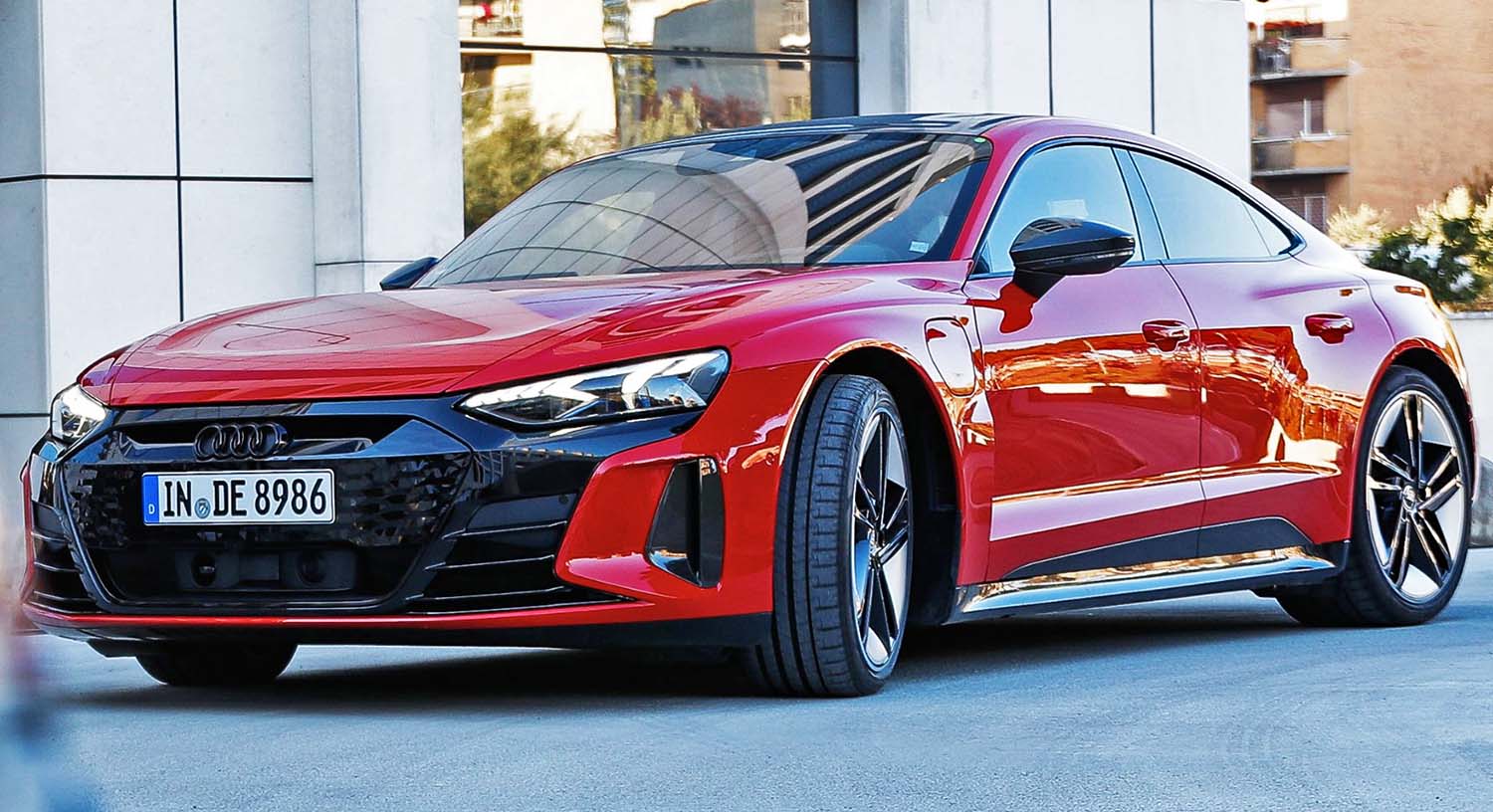
Battery and thermal management
The lithium-ion battery system of the Audi e-tron GT quattro2 and the RS e-tron GT3 is located between the axles, at the car’s lowest point. This provides a low center of gravity appropriate for a sports car and a weight distribution between the front and rear axles that is very close to the ideal value of 50:50.
The high-voltage battery can store 85 kWh of energy net (93 kWh gross) in both models. It integrates 33 cell modules, each of which comprises twelve pouch cells with flexible outer skin. 30 modules form the lower level that features a wide recess in the rear section which creates space for the rear passengers’ feet. The upper “floor” of the battery contains three further modules situated below the rear seats. The connections, fuses, and the main control unit are located under the center console. The system voltage of 800 volts enables a high continuous output and shortens the charging duration; in addition, it reduces the weight of and space required by the wiring.
The inner structure of the battery that houses the modules as well as the frame surrounding it are made of lightweight aluminum. The battery system contributes significantly to the rigidity and crash safety of the body to which it is attached via 28 screws. Beneath its cell space there is a compound structure of flat extruded sections through which coolant flows that circulates in its own low-temperature circuit. The battery’s feel-good temperature is between 30 and 35 degrees Celsius.
High-tech thermal management: four separate coolant circuits
Four separate coolant circuits regulate the temperature in the high-voltage components and the interior, each at its own temperature level. They can be interconnected flexibly as required. If the driver demands a high output several times in a row, valves couple the coolant circuit of the battery with the refrigerant circuit of the air conditioning system – the intensive cooling keeps the performance of the drive at a consistently high level. The refrigerant circuit also helps with cooling during fast DC charging, which can heat the battery up to 50 degrees Celsius.
The standard equipment of the e-tron GT2 includes a heat pump that heats the interior with the waste heat of the high-voltage components. It can reduce the loss of range caused by climate control significantly, especially in winter when it replaces the thermoelectric heating element. Customers can manage pre-entry climate control of the interior and charging via their smartphones using the myAudi app. The e-tron GT is equipped with a deluxe auxiliary air conditioning system as an option that also incorporates the exterior mirrors and the rear window.

From 11 to 270 kW: AC and DC charging
The charging flaps of the gran turismo are located behind the front wheels. Both sides feature connections for alternating current (AC) and there is also a connection for direct current (DC) on the right-hand side.
The Audi e-tron GT2 is delivered to its customers with two charging cables: one mode 3 cable for public terminals and the charging system compact for the garage. The intelligent charging system connect is available as an alternative here. Its internet connection enables both control via the myAudi app and function updates. In cooperation with a suitable home energy management system, the charging system connect offers further smart functions, such as charging when electricity is less expensive under a variable electricity rate.
The e-tron GT can charge with 11 kW AC as standard, which allows it to recharge an empty battery over night. An optional charger for 22 kW will follow shortly after the market launch. At a sufficiently powerful DC terminal, the electric gran turismo achieves a peak charging capacity of up to 270 kW. This allows it to recharge energy for up to 100 kilometers (62.1 mi) in just over five minutes Charging from 5 to 80 percent SoC (state of charge) takes just 22.5 minutes under ideal conditions.
Customers in Europe can use the Audi brand’s own e-tron Charging Service, which currently comprises around 200,000 public charging points. They can access these charging points with one card. Audi customers pay a uniform rate in 26 countries. They enjoy favorable conditions in the Europe-wide fast-charging network from Ionity. In the first year, Audi covers the basic fee for the transit rate, which offers a reduced price for electricity.

In the NEDC cycle, the Audi e-tron GT quattro2 consumes 19.6–18.8 kWh of energy per 100 kilometers (62.1 mi) on average, the RS model3 consumes 20.2–19.3 kWh. This results in average ranges of up to 487 kilometers (302.6 mi) and 472 kilometers (293.3 mi) (according to the WLTP measuring procedure), respectively.
Suspension
The suspension is one of the elements that play a crucial role in shaping the harmonious overall character of the Audi e-tron GT quattro2 and the RS e-tron GT3. It is a congenial partner to the dynamic drive, while always remaining confident and relaxed no matter how much strain is put on it. This, too, perfectly embodies the gran turismo philosophy.
The wheel suspensions are designed as a sporty double wishbone construction. Almost all parts, including the links and subframes, are forged or cast from aluminum. The electromechanical steering has a sporty and direct ratio without appearing abrupt. Audi supplies all-wheel steering as an option. A spindle drive turns the rear wheels by a maximum of 2.8 degrees here – in the opposite direction up to a speed of around 70 km/h (43.5 mph) to increase agility and handling and reduce the turning circle, and slightly in the same direction from a speed of around 80 km/h (49.7 mph) in the interest of stability.
Up to 21 inches and 420 millimeters (16.5 in): wheels and brakes
The portfolio of alloy wheels starts with the 19-inch format for the Audi e-tron GT quattro2 and – for both models – ends with the 21-inch format. The 20-inch format in the middle of the range (standard for the RS e-tron GT3 ) is available in three designs. A new production process used for the aluminum from which these wheels are made reduces net CO2 emissions considerably. Almost all tires are optimized in terms of rolling resistance; for the 21-inch format, performance-focused tires are available as an alternative.

There are also differences between brakes in the two models. Steel disks come as standard with the e-tron GT quattro2, while the RS model3 is fitted with cast iron disks with a tungsten carbide coating (optional in the e-tron GT quattro). It increases the braking performance and reduces wear and therefore brake dust. At the same time, it prevents flash rust, a typical phenomenon seen in many electric cars that do not use their wheel brakes very often. At the peak of the portfolio, brake disks made of carbon fiber ceramic, which are especially lightweight, powerful, and durable, are available as an option for both models. They have a diameter of 420 millimeters (16.5 in) at the front axle. Their ten-piston calipers come in gray as standard and are painted in red or blue as an option.
Precisely controlled: air suspension and damping
While the adaptive suspension is optional in the Audi e-tron GT quattro2, it is on board as standard in the RS model3. Its three-chamber air suspension enables comfortable basic suspension and can adjust the body to different s – 22 millimeters (0.9 in) downward and 20 millimeters (0.8 in) upward. The chambers in each spring can be activated and deactivated individually to suit the driving situation, and they work closely together with the controlled dampers (standard). Both systems are managed by a central control unit, the electronic chassis platform (ECP).
In the Audi drive select dynamic handling system (standard), the driver can specify how the air suspension, dampers, electric motors, two-speed transmission, and controlled rear-axle differential lock (standard with the RS model) are to operate. They can switch between the “comfort,” “efficiency,” “dynamic,” and “individual” modes via a switch. In “efficiency” mode, the body is lowered to the low level to promote better air flow and the top speed is limited to 140 km/h (87.0 mph). In “dynamic” mode, the electric all-wheel drive, the suspension systems, and active aerodynamics are set to a sporty mode.
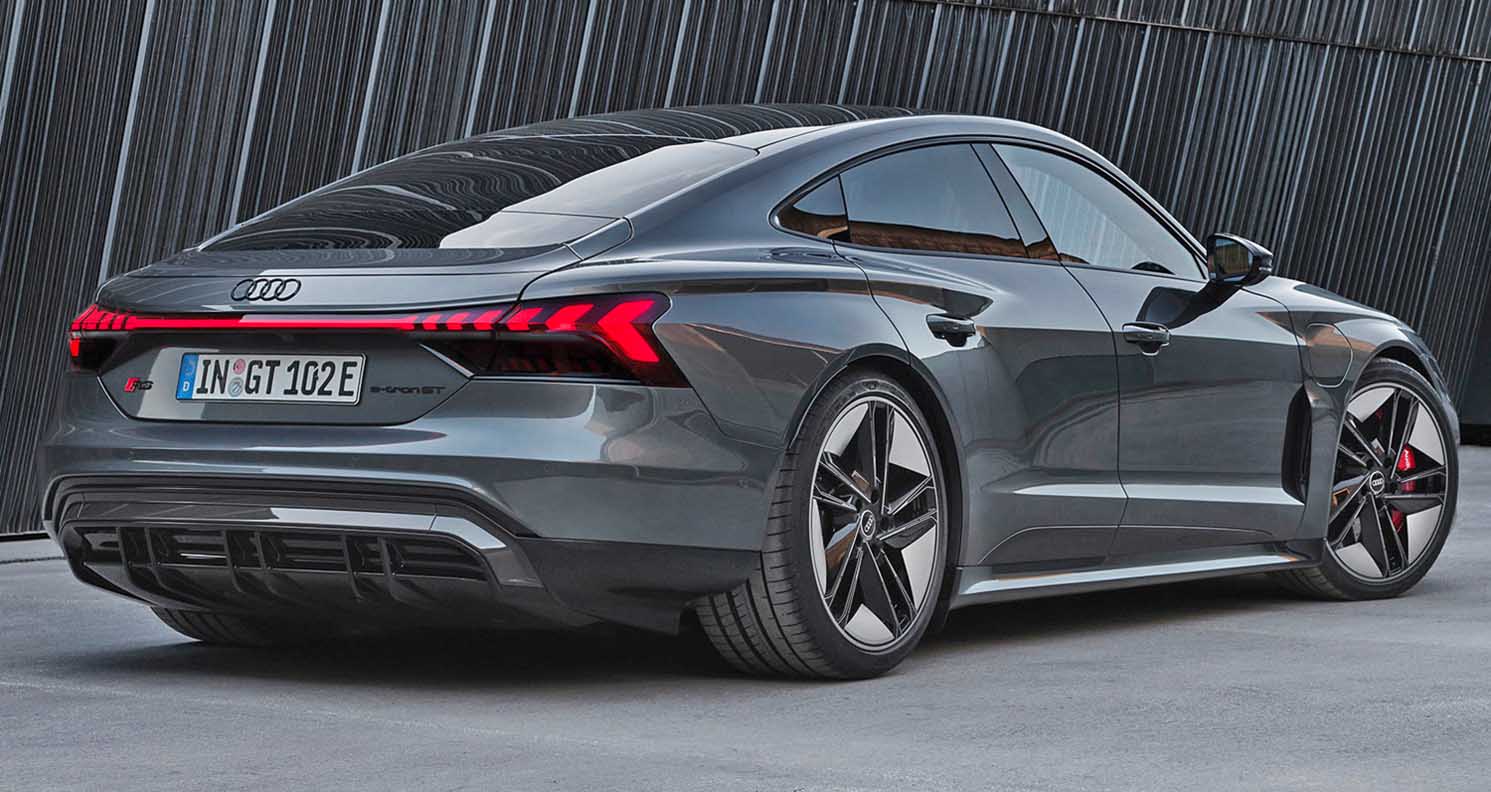
For dynamic handling: rear-axle differential lock
A mechanical part at the rear axle complements the electric all-wheel drive. The Audi e-tron GT quattro2 comes as standard with a differential lock with fixed locking values during both thrust and traction. It improves traction and stability and reduces load change reactions; minor brake and steering interventions on the wheels round off its work. The controlled rear-axle differential lock is available as an option and is standard with the RS e-tron GT3. The multi-plate clutch is its core element. It can be actuated fully variably, and the locking range extends from zero to 100 percent. The driver can perceive this on slippery road surfaces and during maximum full-stop braking in particular: In this case, the lock opens up completely, allowing the Electronic Stabilization Control (ESC) to brake each wheel with great precision.
Driver assist systems
The Audi e-tron GT quattro2 and the RS e-tron GT3 are being introduced to the market with a wide range of driver assist systems. The Audi pre sense front and Audi pre sense basic safety systems are standard, as are the lane departure warning system and cruise control system. The optional systems are subdivided into the “Tour,” “City” and “Park” packages.The assist package plus integrates all three of them. The night vision assist and surround view cameras (also available in the “Park” package) are available in addition. All systems use the central driver assistance controller (zFAS), which uses the sensors’ data to continuously compute an exact model of the vehicle’s environment.
The adaptive cruise assist, which assists the driver with longitudinal and lateral guidance in many situations, is the most important system in the “Tour” package. When the predictive efficiency assist (standard) is active, the adaptive cruise assist decelerates and accelerates the gran turismo in such a way that it consumes as little energy as possible.

The (remote) park assist plus is one of the highlights of the “Park” package. It maneuvers the Audi e-tron GT2 into and out of a parallel or bay parking space at the push of a button. The driver is responsible for the maneuver. They can remain inside the car or get out – in this case, they start and supervise the parking maneuver via the myAudi app on their smartphone. By keeping the corresponding button pressed, the car will roll into the space, in multiple maneuvers if necessary. Once it has reached its final position, it switches off the drive, activates the parking lock, and locks the doors.
e-tron sport sound
Since the dynamic work of art should also sound good, Audi has composed a unique sound for the e-tron GT2. The optional e-tron sport sound (standard with the RS e-tron GT**) comprises two control units and amplifiers in the luggage compartment. They generate a separate exterior and interior sound, which is output by two loudspeakers each outside and inside the vehicle. Data about the rotational speed of the electric motors, the load, the vehicle speed, and other parameters serves as the basis for the digital sound. This creates a synthesized sound that provides an authentic and finely nuanced impression of the work performed by the drive system.
Drivers can modulate the sound via Audi drive select. In the “efficiency” profile, only the AVAS (Acoustic Vehicle Alerting System) is active, which already generates a broader sound than is legally required. The exterior sound becomes fuller and more high-quality in “comfort” mode. The “dynamic” profile makes it even more powerful, and the interior sound is added. The e-tron sport sound is sporty, voluminous, and high-quality at the same time and is an acoustic expression of the progressive gran turismo character.
Controls and displays
In terms of controls and displays, the e-tron GT quattro2 and the RS e-tron GT3 follow the current Audi concept: All information appears on two large displays. The driver operates the Audi virtual cockpit plus (12.3 inches) via the multifunction steering wheel and controls the central MMI touch display (10.1 inches) via touch. Behind the control and display functions in the e-tron GT quattro2 and the RS e-tron GT3 is the state-of-the-art third generation modular infotainment platform (MIB 3).
The freestanding Audi virtual cockpit plus behind the flat-bottomed steering wheel provides a high resolution of 1,920 x 720 pixels and allows the driver to switch between three screens: classic, sport, and e-tron. In the e-tron view, the focus is on the large powermeter that displays the status of the drive and all important information on electric driving. The driver manages the infotainment, navigation, comfort functions, and text input via the MMI touch display, which provides acoustic feedback.
The third control level is the natural voice control which understands many expressions from everyday language. It uses both onboard information and knowledge from the cloud to respond to the input. The optional head-up display can display important information on the windshield. The image window is in the driver’s field of vision, with the projection appearing to float about three meters (9.8 ft) in front of them.
The personalization is a convenient function of the Audi e-tron GT2. Up to six users can each store their preferred settings in individual profiles. The data is stored in the customer’s myAudi account. The car adjusts the individual settings when the driver’s door is opened.
Infotainment and Audi connect
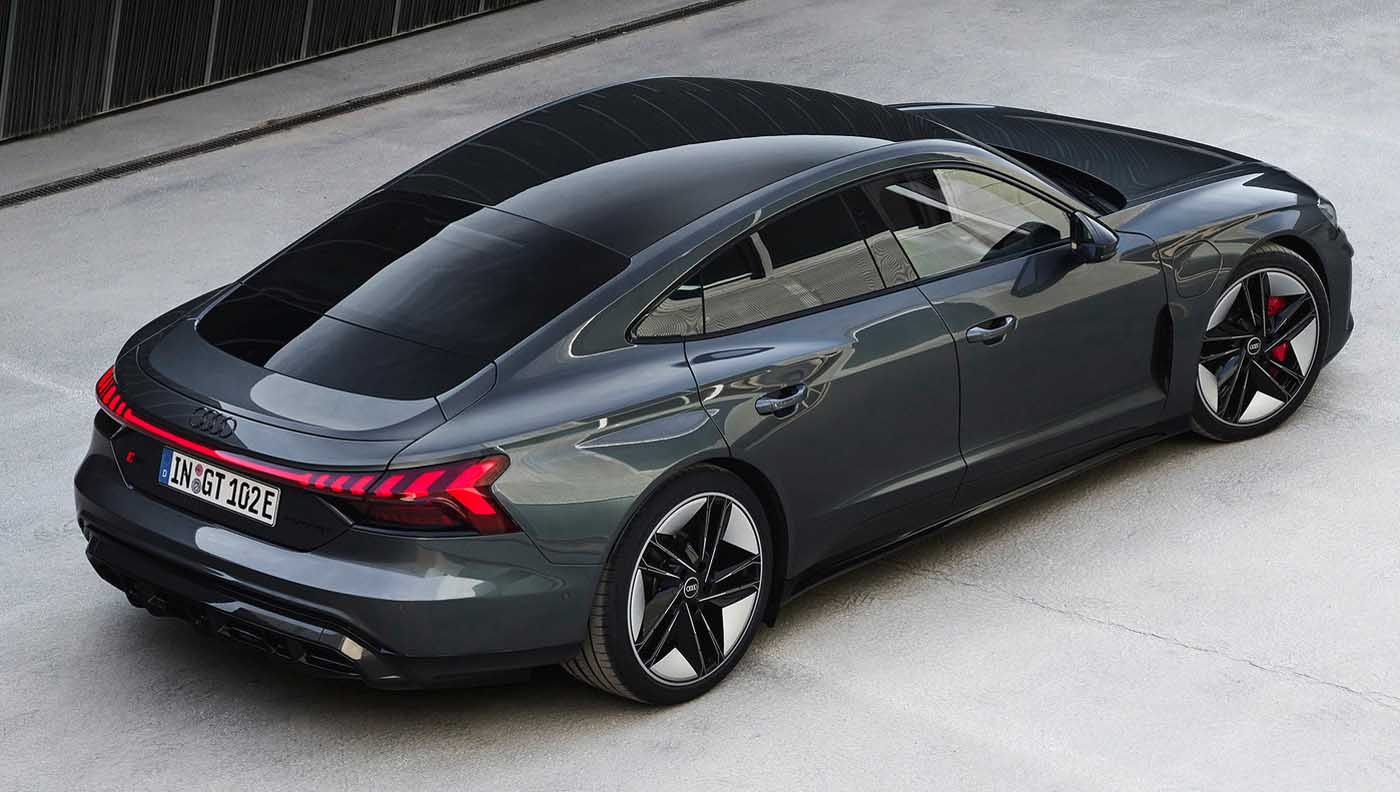
Eleven antennas, all of which are integrated where they cannot be seen, connect the e-tron GT2 with the outside world. They receive and transmit audio, LTE, Bluetooth, and GPS signals, thereby connecting the electric gran turismo to the environment and its owner in many different ways. The customer can control many functions via the free myAudi appon their smartphone.
The MMI navigation plus media center comes as standard in both e-tron GT models. It supports the fast LTE Advanced transmission standard with integrated Wi-Fi hotspot for the passengers’ devices. The navigation system offers destination suggestions based on previously driven routes, and route calculation both in the car and online is performed on the servers of service provider HERE. To do this, it uses real-time data from the entire traffic situation.
The Audi connect online services are split into two packages. The Audi connect emergency call & service with Audi connect remote & control section enables the remote control of the locking system, charging, and climate control. The Audi connect navigation & infotainment package includes services such as traffic information online, navigation with Google Earth™, and Amazon Alexa. Car-to-X services output warnings regarding hazards and help with finding free parking spots on the roadside or allow the driver to surf the green wave by communicating with traffic lights.
The e-tron route planner, a further service from Audi connect, calculates the fastest route with the shortest possible charging stops. In doing so, it also takes traffic data and the driver’s driving profile into account. The e-tron route planner is connected to the car’s thermal management. This enables high-speed charging if the driver has selected a powerful DC terminal as the destination in the navigation system. Roughly half an hour before arrival at the terminal, the thermal management intensifies the cooling of the battery so that it can charge as quickly as possible. Should the battery still be very cold shortly after the car is started in winter, it is heated for fast charging.
Attractive hardware modules supplement the infotainment portfolio. The Audi phone box, which is available in two versions, links smartphones to the vehicle’s antenna and charges them inductively.

The Bang & Olufsen premium sound system, which comes as standard with the RS model3, ups the ante with an output of 710 watts. Among its 16 loudspeakers are two 3D loudspeakers in the A-pillars.
Craftsmanship meets smart factory
The e-tron GT2 is the first fully electric car from Audi to be built in Germany. It rolls off the line in the Audi Böllinger Höfe at the Neckarsulm site. The small-series production facility there has been expanded and converted for its new role. The skilled craftsmanship of the previous facility has been supplemented by digital processes and smart technologies. During the expansion, production planners made use of new virtual methods. Production of the e-tron GT2 was designed without physical prototypes – a first at Audi.
The body shop combines the skilled craftsmanship of the employees with the full potential of automated production technology. It consists of an innovative body assembly line along which each body passes twice. It is constructed around what is called the two-way framer, in which ten robots are used to attach the inside and outside. It combines all manufacturing steps for joining the side panels in a single system – thus making production of the Audi e-tron GT possible on the existing floorspace. What is known as the correlation-free inline measuring procedure for the bodies is also new. It guarantees even greater accuracy and can respond very quickly to minute deviations. At the end of the body assembly line is where precise craftsmanship comes into play: Experienced workers fit the add-on parts and check the completed body.
The e-tron GT2 shares the assembly line with the Audi R8 high-performance sports car – this integration of two technically completely different cars is unique in the Volkswagen Group. The expanded assembly line includes 36 instead of the previous 16 cycles. Both models are moved using the same driverless transport vehicles and an electrically powered monorail system, with humans and robots working side by side at one station of the line. Once completed, every car is driven for 40 kilometers (24.9 mi) on public roads, which also includes sections on the highway and in urban traffic.
The production of the Audi e-tron GT quattro2 and the RS e-tron GT3 in the Böllinger Höfe is carbon-neutral. Just like at the entire Neckarsulm site, production uses 100 percent eco-electricity, with a combined heat and power plant fired with biogas providing the necessary heat for the Böllinger Höfe. Emissions that cannot yet be avoided are compensated with carbon credits from certified climate protection projects.

Audi also relies on resource-conserving vehicle manufacturing. This way, production at the Böllinger Höfe avoids the use of paper and packaging and uses closed-loop systems, for example. The aluminum sheet waste that accumulates in the press shop, for example during the production of the side wall frame, is returned to the supplier, where it is reconditioned and then reused at Audi. Audi has launched a pilot project for plastic recycling. Plastic waste is processed into fibers, and these filaments are then used in 3D printers to manufacture tools for the production process.
Positioning
- Reinterpretation of the gran turismo philosophy: four-door coupé with an elegant and dynamic design and powerful electric drive; great confidence on long distances and in everyday driving
- RS e-tron GT1 as the spearhead of electrification at Audi and Audi Sport GmbH
- Emotive signature car and preview of future design
Exterior design, aerodynamics, and body
- Gran turismo design further developed under the flag of electric mobility: Sportiness and comfort meet sustainability
- Sporty proportions: large wheels, wide track, flat silhouette, long wheelbase
- Flowing design language as the new design feature: Aesthetics arise from efficiency
- Sculptural design: a low inverted Singleframe grille in vehicle color; highly distinctive quattro blisters; a flat greenhouse with a sloping roof line; rear end with extreme indentations
- Low drag coefficient of just 0.24 enables high efficiency and a long range; active aerodynamics with switchable air inlets for brakes and radiators, as well as a rear spoiler that extends in multiple stages; closed underbody and wide diffuser
- High rigidity and crash safety thanks to ultra-high strength steel in the passenger cell and a reinforcing battery housing; aluminum outer skin
- Length: 4.99 meters (16.4 ft); width: 1.96 meters (6.4 ft); : just 1.41 meters (4.6 ft); flat body line; luggage compartment with a volume of 405 liters (14.3 cu ft) in the rear (366 liters (12.9 cu ft) in the RS model**)
Headlights and lights
- Matrix LED headlights are standard in the RS e-tron GT1 and available as an option with the e-tron GT quattro2
- Matrix LED headlights with Audi laser light are available as an option for both models; they double the range of the high beam
- Rear lights with a light band; dynamic coming home and leaving home animations in combination with the top-of-the-range headlights

Interior design and interior
- Instrument panel with driver orientation and “monoposto character,” open feeling of space
- Low seat position and wide center console; rear seat bench is also suitable for adults
- Sustainability meets sportiness and comfort: leather-free interiors, upholstery made with a high percentage of recycled material
- There are three seat variants and a choice of multiple design packages
Drive and recuperation
- Electric all-wheel drive with one permanently excited synchronous machine (PSM) each at the front and rear axles; two-speed transmission at the rear axle
- The Audi e-tron GT quattro2 has a total output of 350 kW (476 PS) and 630 Nm (464.7 lb-ft) of torque (in boost mode 640 Nm (472.0 lb-ft)), while the RS e-tron GT1 outputs 440 kW (598 PS) and 830 Nm (612.2 lb-ft) of torque; launch control provides a boost output of 390 kW (530 PS) or 475 kW (646 PS), respectively, for a maximum of 2.5 seconds
- 0–100 km/h (62.1 mph) in 4.1 or 3.3 seconds (RS model), respectively
- Top speed of 245 km/h (152.2 mph) with the e-tron GT quattro and 250 km/h (155.3 mph) with the RS model
- Intelligent control of coasting and recuperation, brake recuperation of up to 265 kW

Battery and thermal management
- Lithium-ion battery with a net energy content of 85 kWh (93 kWh gross) and a voltage level of 800 volts; 396 pouch cells in 33 modules
- AC charging with an output of 11 kW as standard and, shortly after market launch, optionally with 22 kW; DC charging with an output of up to 270 kW as standard
- Range of up to 487 km (302.6 mi) with one charge in the WLTP (Audi e-tron GT quattro2); very short charging times: just five minutes for a distance of roughly 100 km (62.1 mi).
- Sophisticated thermal management with four cooling circuits, efficient heat pump as standard;Preconditioning for fast DC charging on the road
- e-tron Charging Service with around 200,000 charging points in Europe and attractive rates
Suspension
- Low center of gravity and excellent axle load distribution thanks to the installation position of the battery and the arrangement of the electric motors
- Standard: controlled damping, rear-axle differential lock, Audi drive select dynamic handling system
- Optional (standard in the RS model1): controlled rear axle differential lock and three-chamber air suspension adaptive air suspension; optional for both models: all-wheel steering
- Brake disks with tungsten carbide coating as an option (standard with the RS model); brake disks made of carbon fiber ceramics optional for both models
- 19- to 21-inch wheels, most of which feature aero design; 20- and 21-inch wheels with aero blades
Driver assist systems
- Audi pre sense safety systems as standard; optional “Tour,” “City,” and “Park” packages; adaptive cruise assist, and (remote) park assist plus as highlights
e-tron sport sound
- Standard AVAS sound is already more sonorous than legally prescribed
- e-tron sport sound available upon request for additional exterior and interior sound (standard in the RS e-tron GT1 ), adjusted depending on the Audi drive select setting
Controls and displays
- Audi virtual cockpit plus (12.3 inches) and MMI touch display (10.1 inches) as standard, plus natural voice control with online connection; head-up display optional; personalization as standard
Infotainment and Audi connect
- MMI navigation plus with Wi-Fi hotspot as standard, intelligent navigation with e-tron-specific functions
- Extensive portfolio of Audi connect services; e-tron route planner for calculating the fastest route with the shortest possible charging stops
- Audi phone box and Bang & Olufsen premium sound system (standard in the RS model1 ) available as an option
Craftsmanship meets smart factory
- Production of the e-tron GT2 at Audi Böllinger Höfe at the Neckarsulm site, as a combination of smart factory technology and craftsmanship
- Carbon-neutral production, use of eco-electricity and biogas
- Independent, innovative body shop, shared assembly line with the Audi R8
